
Annapurna Base Camp trek is perfect for beginners hiking in Nepal for the first time. This relatively short hike, which can be done in 6-10 days, takes you to the heart of the Himalayas, offers unforgettable views of Annapurna and Machapuchare, and is not difficult at all. Check out this Annapurna Base Camp trek itinerary blog post to:
- see if Annapurna Base Camp trek is worth it;
- choose the most suitable Annapurna Base Camp trek itinerary (6-day, 8-day or 10-day route);
- learn how to plan your trek independently without a guide (best time to go, permits, costs);
- read my detailed day by day itinerary packed with tips.
IMPORTANT UPDATE: On 9 March 2023, the Nepal Tourism Board (NTB) announced that foreigners, whether solo or in a group, will no longer be allowed to trek in Nepal without a guide. From April 1, all hikers must be accompanied by a licensed guide. Read about the new rule here: BAN ON TREKKING IN NEPAL WITHOUT THE GUIDE – HAS THE RULE COME INTO FORCE? – UPDATE FROM THE TRAILS
What's in this blog post?
I. IS ANNAPURNA BASE CAMP TREK WORTH IT?
The short answer is yes, but let me explain.
A short trek with ever-changing scenery
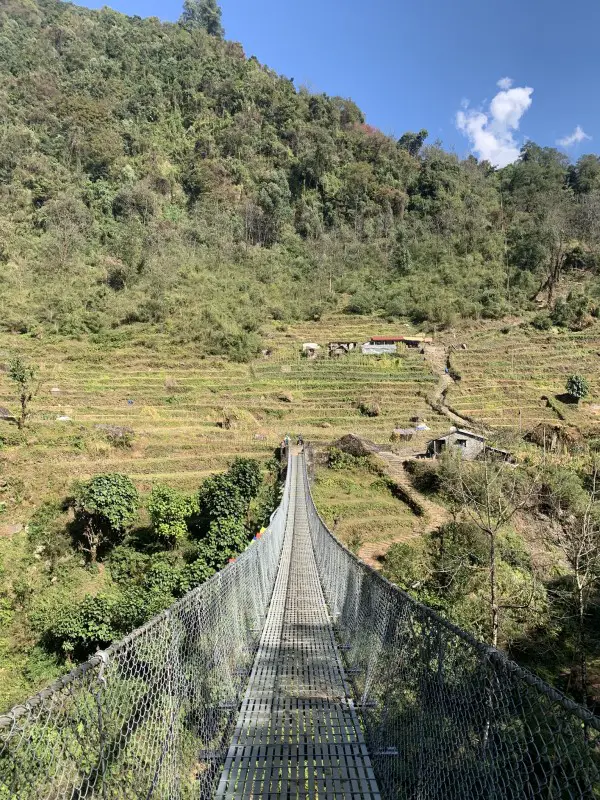
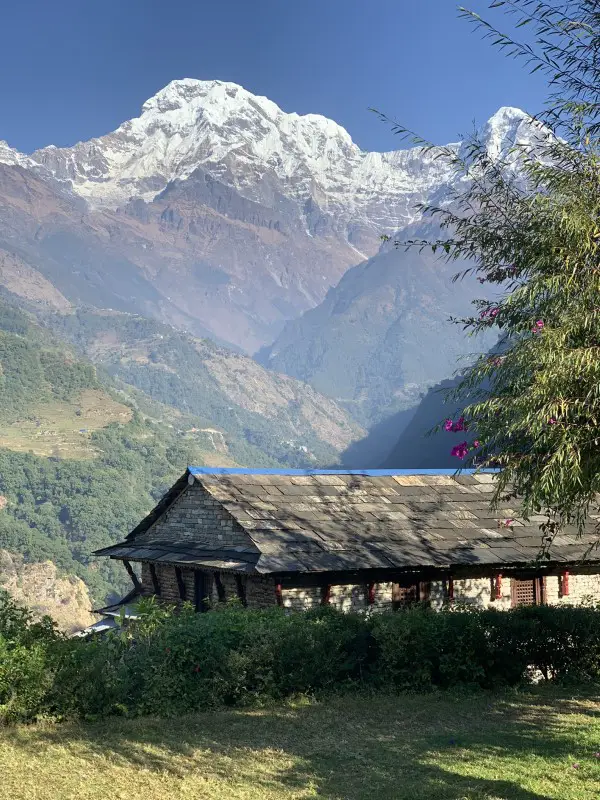
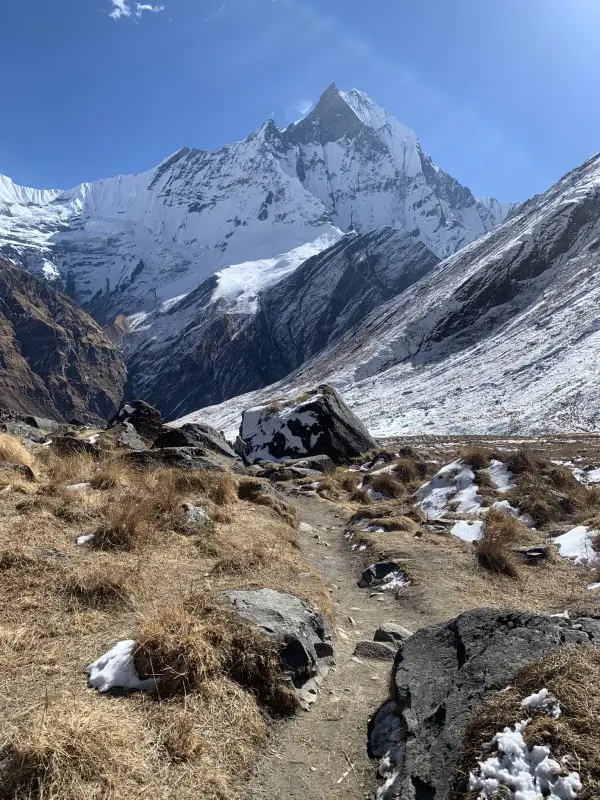
ABC trek offers the best Machapuchare and Annapurna views
Trekking to the Annapurna Base Camp is the best way to enjoy the views of Machapuchare, one of the most characteristic mountains in the world, from all sides and up-close as well as the breathtaking Annapurna Range. Its main peak – Annapurna I reaching over 8,000 metres, is hardly visible on the Annapurna Circuit, but exposed in all its glory during the Annapurna Base Camp trek.
By the way, if you are still unsure about the Annapurna Base Camp trek and considering the Annapurna Circuit instead, you might want to read this post: ANNAPURNA CIRCUIT vs. ANNAPURNA BASE CAMP TREK COMPARISON – WHICH TREK TO CHOOSE?
The same Machapuchare on two different days - always breathtaking!

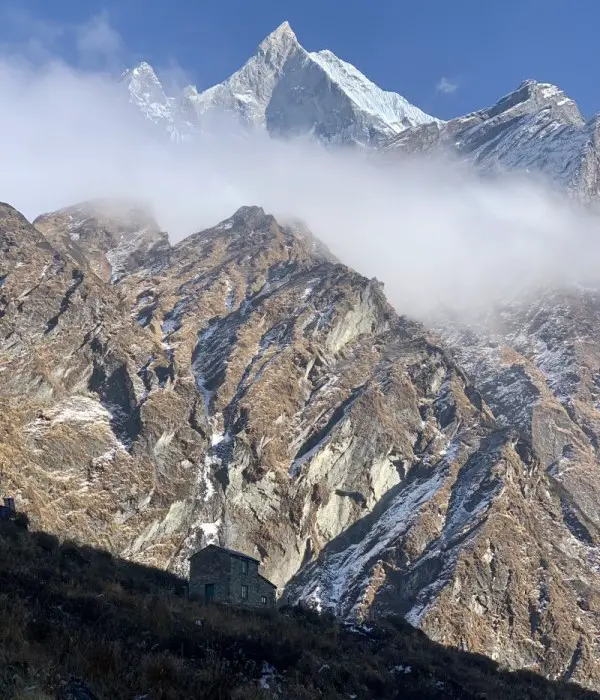
Annapurna Base Camp trek is not so crowded
Annapurna, the world’s 10th highest peak, is named after the Hindu goddess of harvest, fertility and abundance. Its massif stretches for almost 50 kilometres and includes four main summits: Annapurna I (8091 m), Annapurna II (7937 m), Annapurna III (7555 m) and Annapurna IV (7525 m).
Although Annapurna is one of the most interesting eight-thousanders among mountain lovers, it is not as famous as Everest – the highest mountain in the world. Therefore, the Annapurna Base Camp trek (both the route and the base) is less crowded than Everest Base Camp trek.
Annapurna, along with K2, is considered the most difficult eight-thousander to climb. It is not even that technical, but extremely dangerous due to the avalanche risk. According to Wikipedia: as of 2022, 365 people reached the Annapurna’s summit and 72 had died in the attempt. The mortality rate of 20% is slightly lower than K2’s figure (24%).
The first successful ascent was made by a French expedition in 1950. In 1987, the Polish team was the first to conquer Annapurna in winter. As a Pole I am very proud of it.

The huge Annapurna massif
and my little coffee in Pokhara 😉
A chance to enter the mystical Annapurna Sanctuary
The Annapurna plateau where the base is located is often called the Sanctuary as it is the home of Hindu and Buddhist deities and their treasury. The narrow valley between the peaks of Hiunchuli and Machapuchare, is the only entrance to the Sanctuary, making it indeed the perfect place for a treasury. Old beliefs are still alive. Machapuchare is a sacred mountain inhabited by the god Shiva, forbidden to climb to this day. Bringing eggs and meat into the Annapurna Sanctuary remains prohibited.
the entrance to the Annapurna Sanctuary
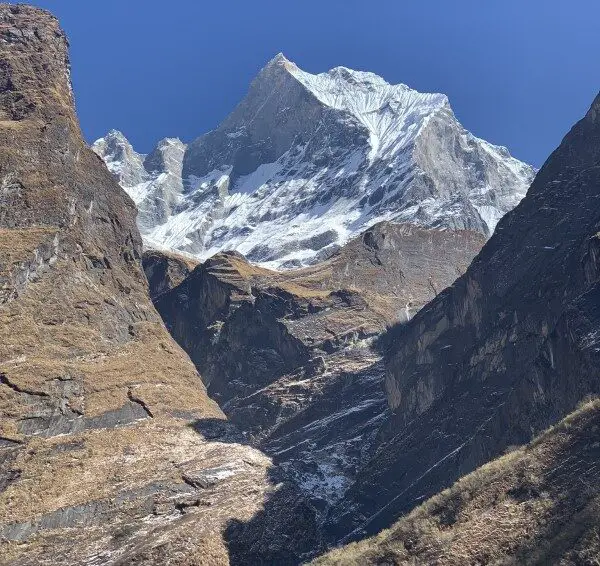
II. PLANNING ANNAPURNA BASE CAMP TREK WITHOUT THE GUIDE
Annapurna Base Camp trek: best time to go
Spring (March-April) and autumn (October-November) are the best times for trekking in the Annapurna region. Due to the greater snowfall in spring and the associated avalanche risk in the narrow valley leading to the Annapurna Base Camp, autumn is a slightly safer choice.
My trekking to Annapurna Base Camp took place in November (from 15 to 24) and weather conditions could not have been better. Except for one day when it relatively quickly got cloudy and chilly, the sky was always blue. It never rained or snowed. The days were sunny and warm. The evenings were much cooler, which is normal in the Himalayas and all you need is warm clothes and a good sleeping bag to keep you warm.
November weather is usually awesome but nights are always cold!


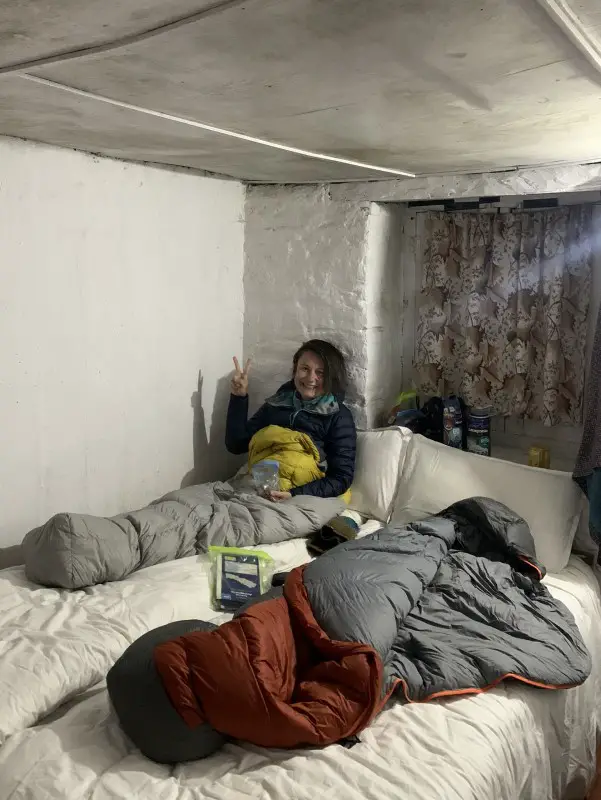
Although the peak season usually lasts until the end of November, according to the locals I spoke to during my trek, it was rather the end of the season already for this year. In fact, the trails and lodges weren’t crowded at all. There were some other trekkers, but not too many, just right not to feel alone.
Annapurna Base Camp trek: permits
You need two permits for the Annapurna Base Camp trek:
- ACAP (Annapurna Conservation Area Project Permit), which costs 3000 NPR;
- TIMS card (Trekkers Information Management System), which costs 2000 NPR, if you trek independently, and 1000 NPR, if you have a local guide.
UPDATE: As a result of the recent ban on independent trekking in Nepal from April 2023, a TIMS card can only be obtained if you are trekking with a guide. Independent trekkers are no longer able to get it. Nevertheless, according to various trekking reports – it is still possible to hike to Annapurna Base Camp both without a TIMS card and without a guide. More details here: BAN ON TREKKING IN NEPAL WITHOUT THE GUIDE – HAS THE RULE COME INTO FORCE? – UPDATE FROM THE TRAILS
Annapurna Base Camp trek permits can be obtained at the Nepal Tourism Board in Kathmandu, which is within walking distance from Thamel. Four passport photos will be required for the documents, so bring them along. The office opening hours are from 10 am to 5 pm but there is a one-hour lunch break from 1 pm. To be on the safe side, come to the office before noon, don’t leave getting the permits until the last minute.
Annapurna permits can also be obtained from the Nepal Tourism Board in Pokhara, in Damside, not far from Lakeside. And if you don’t have time, you can get them through most travel agencies in Nepal for a small fee. You just need to contact the travel agency beforehand and send required documents and your trekking plan.
You'll have to show your permits at Tourist Checkpoints in Birethani and Chhomrong

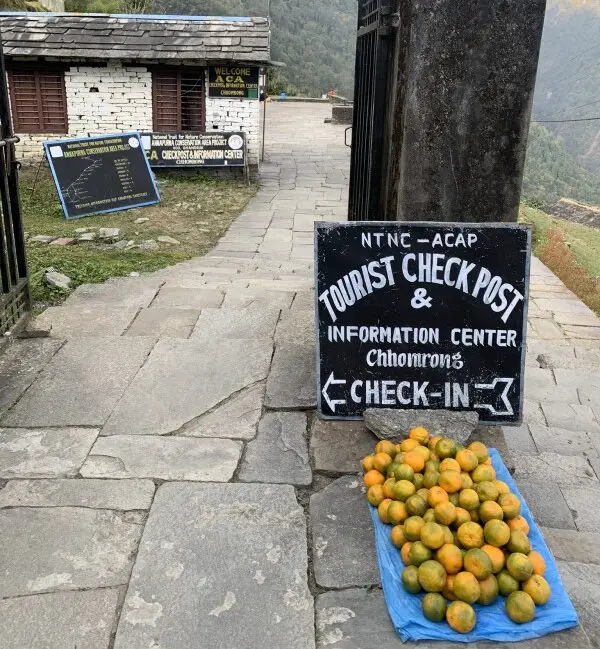
How much does the Annapurna Base Camp trek cost?
The average daily cost of the Annapurna Base Camp trek (food and accommodation) is approximately 2500 NPR per person, which does not include permits and transportation expenses. Be sure to bring enough cash as there are no ATMs and cards are not accepted.
The total Annapurna Base Camp trek cost can be broken down as follows:
- 5000 NPR – trekking permits;
- 20,000 NPR (8 days x 2,500 NPR) – food and accommodation;
- 5000 NPR – a shared jeep from/to Pokhara. The regular fare should be 1000 NPR one way per person (if the jeep is full and if you arrange it without any middlemen). Also, you need to add the cost of a taxi from Lakeside to the jeep station in Pokhara. 5000 NPR is a rough estimate;
- 25,000 NPR return plane ticket from/to Kathmandu.
This means that the total cost of the 8-day Annapurna Base Camp trek is about NPR 55,000 (USD 420/EUR 400). Of course, if you go with a trekking agency, with a guide and/or porter, the total cost of the trek will be much higher.
When it comes to food, the higher you climb, the more expensive it is.
(100 NPR ~ less than 1 USD/ less than 1 EUR)
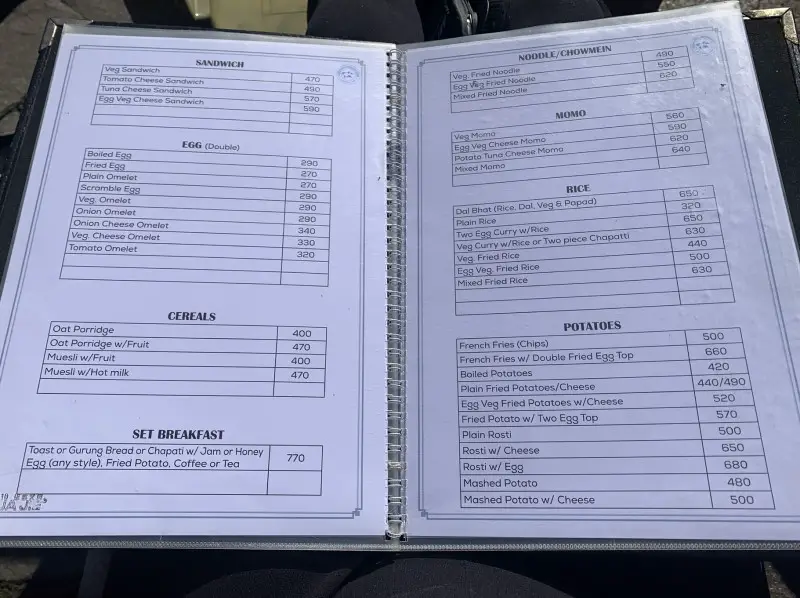
Food prices
in Bamboo(2335m):
breakfast set-770 NPR,
dal bhat-650 NPR
Food prices
in the base camp (4130m): breakfast set-870 NPR,
dal bhat-740 NPR
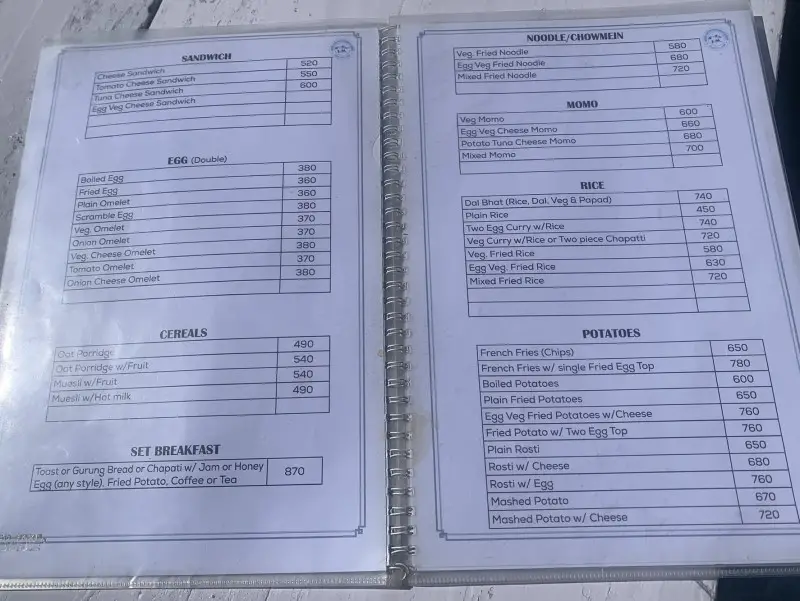
The best way to save money is to travel by bus from Kathmandu to Pokhara instead of flying. However, this requires much more time (8 hours). A bus trip (round trip) should cost no more than NPR 3,000.
There are many ways to save money on the trek. Always eat dal bhat, don’t take hot showers every day, bring your own tea bags and snacks. And when it comes to room prices, you can try to bargain.
How to pack for the Annapurna Base Camp trek?
Packing for Annapurna Base Camp trek is very important and should be planned carefully. That’s why I came up with a separate blog post. To learn about the important packing tips as well as the essential packing list go to WHAT TO PACK FOR A TREK IN NEPAL?
III. GETTING TO THE STARTING POINT OF THE ANNAPURNA BASE CAMP TREK
Where do you start the trek?
You can start Annapurna Base Camp trek from two different sides of the valley (Ghandruk or Landruk) and decide how much road you want to cover by jeep/bus and how much on foot. There are plenty of options.
Starting in Ghandruk is a bit easier (less uphill) and that’s why I chose this route. If you have time, you can start at the very bottom from Nayapul at 1010 m (or any village in between – e.g., Birethani or Kimche) and go via Ghandruk (1940 m) to the base camp. In order to save some time (one day of walking) you can take a jeep to Ghandruk and start walking from there. Since this initial part of the trek is the most tiring (a lot of uphill and downhill, it’s quite hot, plus your back is not yet used to a heavy backpack) I decided to go to Ghandruk by jeep and have more time to enjoy high mountains.
Ghandruk station-
where your trekking adventure may begin
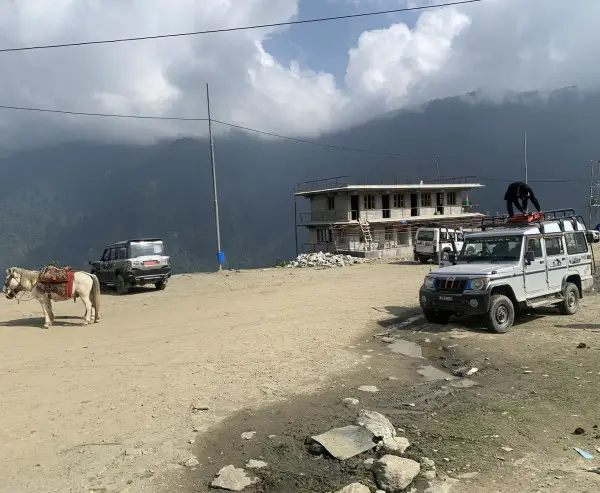
Alternatively you can begin your journey in Landruk or Simring. Starting and finishing in Simring, the furthest place where you can get by jeep, would be the shortest route.
Taking a slightly different route on the way back, exploring both villages – Ghandruk and Landruk and enjoying hot springs in Jhinu (near Simring) at the end of the trek are probably a good idea. That’s why I recommend starting the trek in Ghandruk and finishing in Simring/Landruk.
Combining Annapurna Base Camp trek itinerary with Poon Hill
It is very popular to combine Annapurna Base Camp trek with the route to the Poon Hill viewpoint. It helps in acclimatisation and extends the adventure by 4 days. This would mean starting from Nayapul, 2 hours from Pokhara.
You can also go to Annapurna Base Camp on your way back from the Annapurna Circuit. Head from Ghorepani to Tadapani (instead of going down to Nayapul) if you want to reach the base camp.
Arranging a jeep from Pokhara to Ghandruk/Landruk
If you are trekking independently, you can ask any travel agency in Pokhara to arrange a private or shared jeep. You can also take a taxi to the jeep station, where you can arrange a jeep yourself. This is the cheapest option. It is a 10-minute taxi ride from Lakeside to the jeep station. Hiring a private jeep costs 7000 NPR.
Pokhara jeep station, what a view!

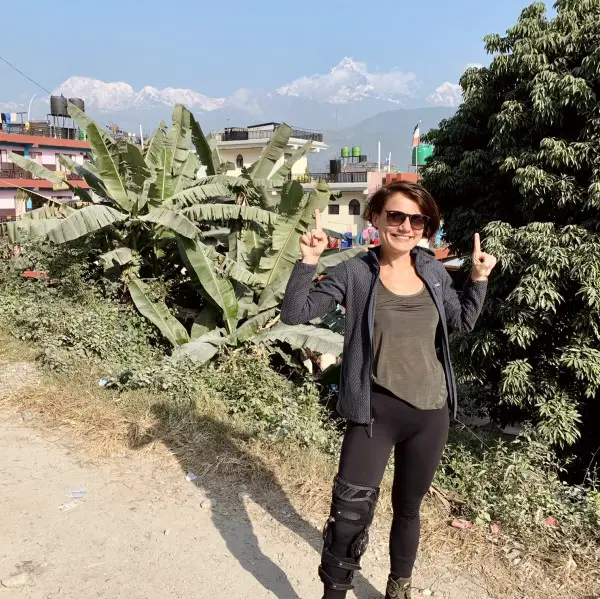
Click here for the JEEP STATION GOOGLE LOCATION
Travelling from Pokhara in a shared jeep
If you want to travel in a shared jeep, when you come at the station, if there are no other people wanting to travel in your direction, you have to wait until they arrive. A typical jeep fits 7 people, so the price per person should be 1000 NPR if there are 7 passengers. If you want to travel in this way, it is best to arrive at the station in the early morning, when most people want to depart. We took our time and were at the jeep station around 9.30. After 40 minutes of waiting, we were in a jeep sharing our bumpy ride with a friendly Nepali family.

waiting for other people to come to share the jeep ride
Is the jeep ride from Pokhara to Ghandruk really so bad?
Well, to be honest, I expected worse. The journey from Pokhara to Ghandruk took us only 2 hours, probably because our driver overtook everyone on the road. Fortunately, he was still driving relatively slowly, because you simply can’t drive fast on such a bad road. Although the road was very bumpy, I did not feel sick, which happens often to me in the car.
Watching the buses on this crazy narrow road was terrifying. I think you should only consider taking the bus if you really can’t afford a jeep. Travelling in an old bus on a mountain road is definitely not very safe and I am usually a risk taker!
Although the journey from Pokhara to Ghandruk took less time than the return trip from Landruk to Pokhara due to the shorter distance on the unpaved road, it was more thrilling. The traffic on the road was heavier, buses were blocking the narrow road all the time.
our jeep & the road
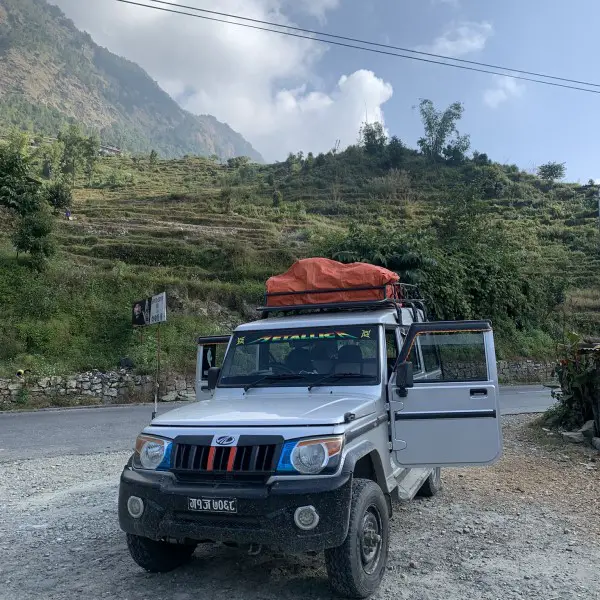
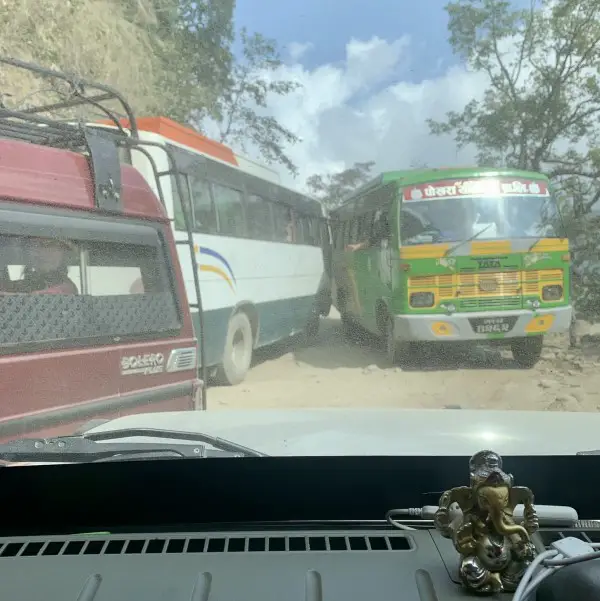
But this Instagram reel shows the jeep ride to Ghandruk probably better than any photo 🙂 CLICK HERE FOR THE SHORT VIDEO
Also, if you are still debating how to get to from Kathmandu to Pokhara, I recently wrote this blog in which I compare all different ways: HOW TO GET FROM KATHMANDU TO POKHARA – 4 WAYS TO TRAVEL
IV. THREE VARIANTS OF THE ANNAPURNA BASE CAMP TREK ITINERARY
You don’t really need to have a detailed plan and know exactly which village and lodge you will spend the night before your trek. Lodges on the route to the Annapurna Base Camp are 1-2 hours apart, which gives you great flexibility. You only need a rough plan and you can choose to stop for the night when you’re tired, the weather gets bad, or you just like the location. This is one of the reasons why I love trekking in Nepal. It is so simple!
If you are trekking with the agency, a guide and/or a porter, lodges are usually decided in advance, although to some extent the schedule can be also amended from what I have observed. I recommend discussing this with the agency before the trek.
Annapurna Base Camp trek starts from Pokhara, which can be reached by bus (8 hours) or by plane (30 min) from Kathmandu. You should add 2 days for travelling to Pokhara from/to Nepal’s capital to each of the below itineraries. If you decide to take a plane, you need to remember that the last flight departs around 2 pm.
Take a look at the suggested Annapurna Base Camp trek itineraries to see which one suits you best.
Shortest 6-day Annapurna Base Camp trek itinerary
- Day 1: Start in Pokhara. Jeep ride to Ghandruk and trek to Chhomrong
- Day 2: Chhomrong – Bamboo
- Day 3: Bamboo – Deurali
- Day 4: Deurali – ABC
- Day 5: ABC- Himalaya
- Day 6: Himalaya – Simrung. Jeep ride to Pokhara
Very busy schedule, long trekking days and not much time for rest. But if you are in good shape, this plan is definitely doable. You might want to consider hiring a porter who will help you to carry your heavy bag. It will help you to maintain a good walking pace while enjoying the beautiful scenery. Arranging private jeeps departing on time from Pokhara and Simrung is a must with such a busy schedule.
Therefore, if you only have 6 days to trek to the Annapurna Sanctuary, it might be worth hiring both a guide and a porter, or joining a larger group run by a trekking agency that will help you with completing the trek on time and a stress-free return home.
If you don't have much time, hiring a porter to carry your backpack is not a bad idea
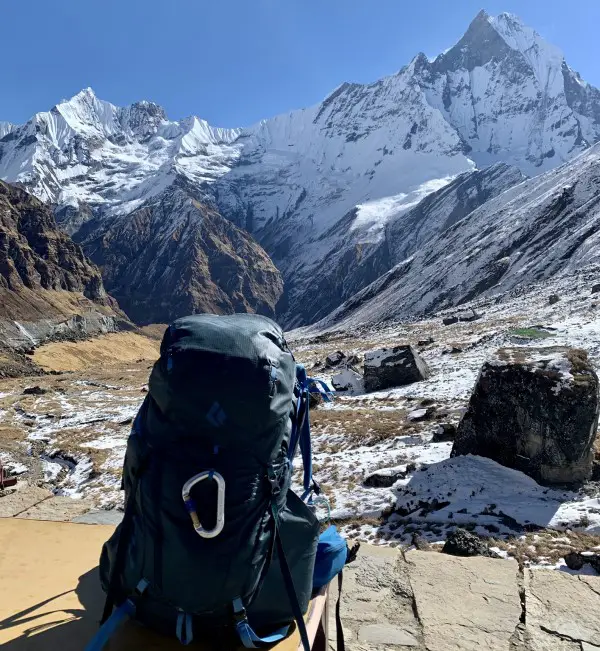
Most popular 8-day Annapurna Base Camp trek itinerary
- Day 1: Start in Pokhara. Jeep transfer to Ghandruk. Sightseeing & relaxing in the village
- Day 2: Ghandruk – Chhomrong
- Day 3: Chhomrong – Bamboo
- Day 4: Bamboo – Deurali
- Day 5: Deurali – ABC
- Day 6: ABC- Bamboo
- Day 7: Bamboo-Chhomrong
- Day 8: Chhomrong – Simrung and jeep ride to Pokhara
An 8-day Annapurna Base Camp trek is probably the most popular option. After adding two days for the travel from/to Kathmandu, the trek duration is exactly 10 days, making it an attractive itinerary for many people. Neither too long nor too short and so beautiful.

10 days (incl. all travels) to experience this magic-not a bad option at all!
Trek & relax: 11-day Annapurna Base Camp trek itinerary
- Day 1: Start in Pokhara. Jeep transfer to Ghandruk. Sightseeing & relaxing in the village
- Day 2: Ghandruk – Chhomrong
- Day 3: Chhomrong – Sinuwa
- Day 4: Sinuwa – Himalaya
- Day 5: Himalaya – MBC
- Day 6: MBC – ABC
- Day 7: ABC- Deurali
- Day 8: Deurali- Bamboo
- Day 9: Bamboo-Chhomrong
- Day 10: Chhomrong-Landruk
- Day 11: Sightseeing & relaxing in the village. Return by jeep from Landruk to Pokhara
This longer route and slower pace represent our way to the Annapurna Base Camp. It can be easily shortened by one or two days. Our average daily walking time was about 4h30min. We hiked for 9 days. The remaining two days were devoted to travelling by jeep from/to Pokhara, sightseeing and relaxing in Gurung villages.
You're coming to Nepal for a holiday, right? So don't forget to relax!
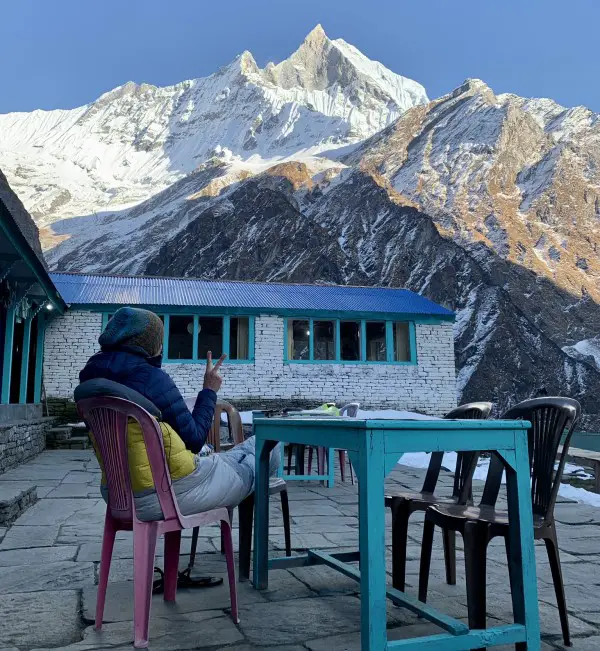
If you want to know the real reason why it took me 11-days to to complete this trek CLICK HERE FOR THE SHORT VIDEO
If you have more than 11 days you might want to consider Annapurna Circuit trek instead. Read more about this legendary route here:
“ANNAPURNA CIRCUIT TREK – DAY BY DAY ITINERARY” to read about the route description, daily distances to cover, tips on how to avoid the road to enjoy the trek.
“ANNAPURNA CIRCUIT – PRACTICAL GUIDE TO PLAN YOUR TREK“ to read about the best time to go and weather, number of days required to complete the Annapurna Circuit trek, how to get to the starting point, permits, food & accommodation, Internet access.
“HOW IS THE ANNAPURNA CIRCUIT EXPERIENCE?” to find out: how difficult is the Annapurna Circuit trek, should you hire a local guide or can you go without, what are the Annapurna Circuit trek pros & cons.
V. ANNAPURNA BASE CAMP TREK: DAY BY DAY ITINERARY
DAY 1. Pokhara 820m > Ghandruk 1940m
2-3 h jeep ride + 20 min walk
Spending time in the village of Ghandruk and Landruk (on the way back from base camp) with its beautifully preserved traditional stone houses gives you a snapshot of everyday life of the local people. The Gurungs, one of the 125 (!) ethnic groups in Nepal, are the indigenous people of the Annapurna region. Nepal is a small country, but very multicultural and Ghandruk is a great place to experience it.
Welcome to Ghandruk

Getting lost in the narrow alleys of the old part of Ghandruk and climbing to a little coffee shop perched on the top of the village were the only things on my agenda during this first relaxing day. I spent the rest of the time sipping tea and watching the slow life of the Gurungs, so different from ours. On the one hand, much harder, but on the other… so simple.

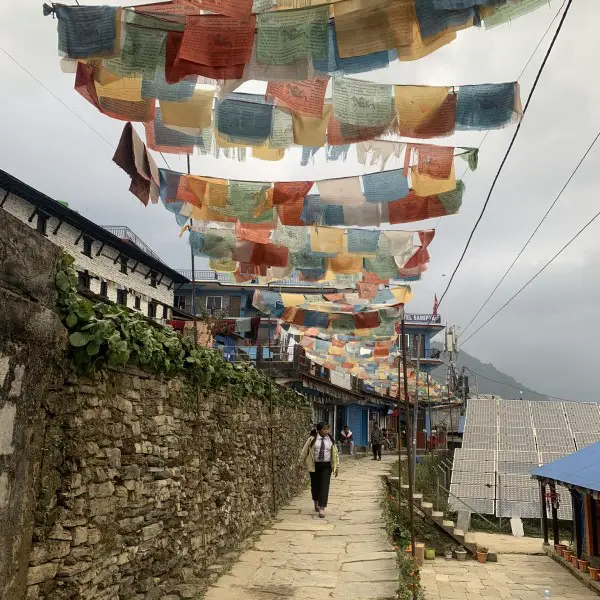
Staying in Ghandruk and how to shorten your trek?
Once you arrive in Ghandruk, finding your way around can be a bit tricky. The new part of Ghandruk village, expanding rapidly since the road completion two years ago, is right above the jeep stop. It takes about 20 minutes to walk to old Ghandruk also called Purano Ghandruk. You can take the main road or one of the smaller paths leading up. As always, the Maps.me app with offline navigation and/or the help of friendly locals can come in handy.
Since the recent post-pandemic boom in local tourism in Nepal, many Nepalese tourists visit Ghandruk. Therefore, the village is not as peaceful as it was in 2017 when I visited it for the first time. That said, it’s still very charming. Just don’t expect a Himalayan village cut off from the rest of the world, because Ghandruk is no longer that.
If you want to save time and shorten your trek, combine Day 1 and Day 2 into one day. Depart Pokhara by jeep as early as possible and trek from Ghandruk to Chhomrong on the first day (2-3 hrs jeep ride + approx. 6-hour walk).
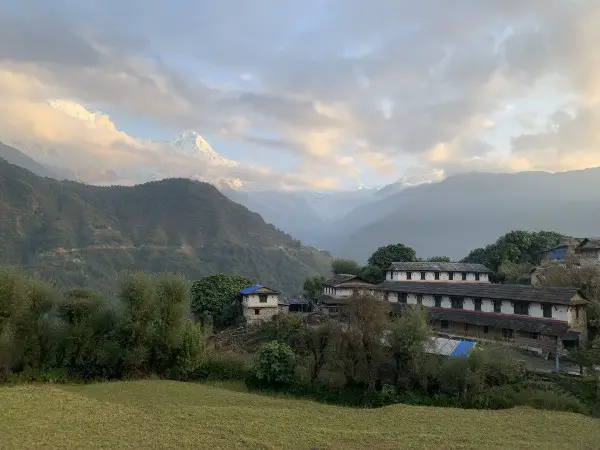
But why would you want to shorten your trek and leave this place quickly?
Accommodation in Ghandruk
There are plenty of options. Prices in Ghandruk are higher due to its easy accessibility and growing popularity among local tourists. You will pay less for a room in more remote locations on the way up to Annapurna Base Camp, which I find very interesting. The same trend, due to the proximity of the airport, I noticed in Jomsom and Kagbeni on the Annapurna Circuit.
We stayed in the last lodge at the end of Purano Ghandruk – Shangri-La Guest House with a spacious terrace with a wonderful view of the Annapurna Range, Machapuchare and traditional stone houses. The hotel has been run for many years by an elderly couple who are now retired. The management of Shangri-La Guest House is now in the hands of a young Nepali with lots of cool ideas in his head. Changes are coming!
Price per night in Ghandruk in Shangri-La – translated as “a remote, imaginary, beautiful place where life approaches perfection”: NPR 1200 for a double room with shared toilet. Not much for a night in heaven 🙂
"a remote, imaginary, beautiful place where life approaches perfection..."

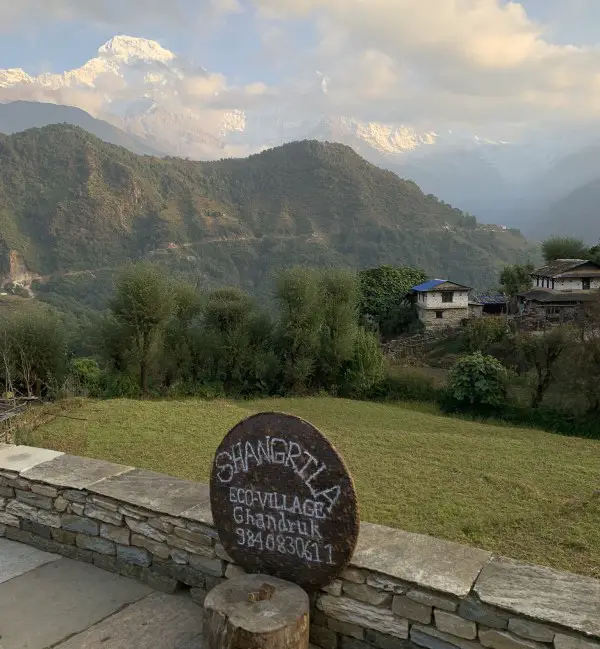
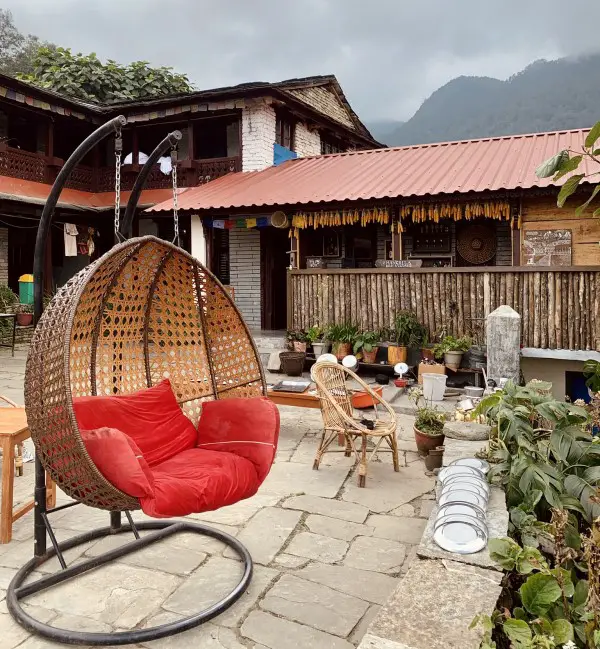
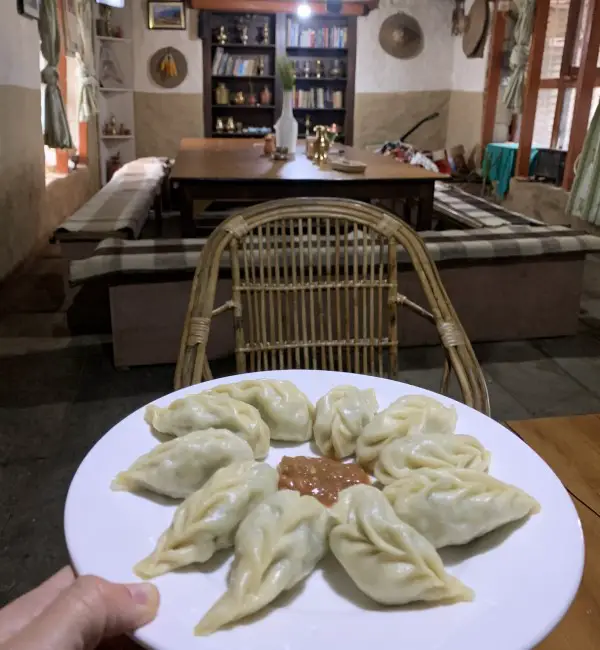
The first day of the trek,
the first momos 🙂
DAY 2. Ghandruk 1940m > Chhomrong 2140m
500m ascent | 300m descent | 9km | 6hrs
We woke up with a breathtaking view of snowy peaks and verdant greenery surrounding Ghandruk, had a cup of coffee and set off at 8.30.

A quick coffee and off we go!
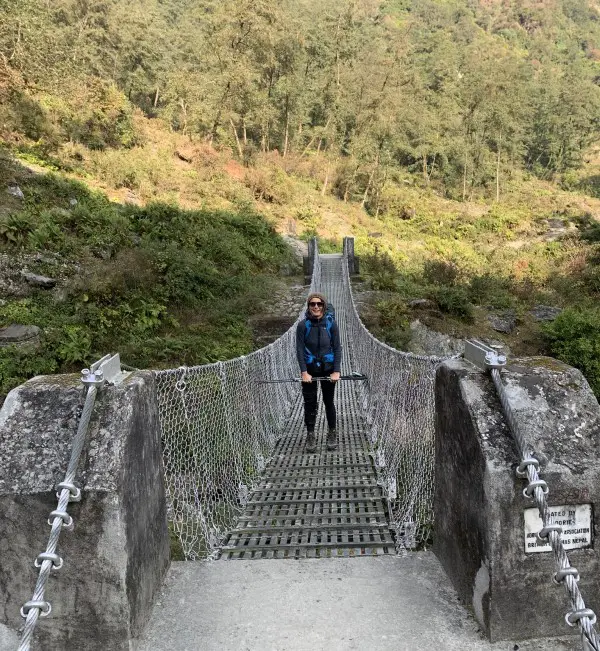
This first trekking day was actually quite demanding due to constant ascents and descents. The climb to Komrong Danda (2100 m), where we had a delicious breakfast (or lunch?) in the sun, took us an hour and a half. At 11 we started descending a steep forest trail to Kimrong Khola (1800 m).

Our first omlette with chapati. At that time we didn't know it would become our daily ritual.
And our route down the valley.
We climbed 250m only to come down... Well, at least lunch was good😉
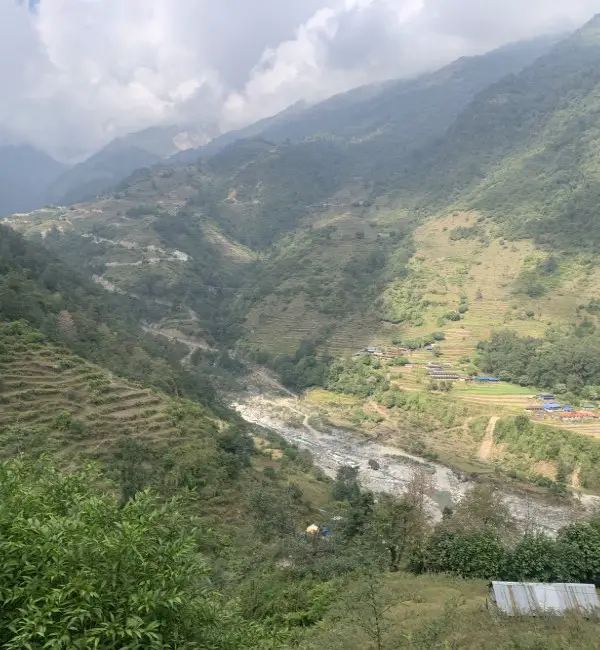
When we finally got to the guesthouse on the opposite side of the river at 12.30 to take a break, I had a little crisis. I felt weak and tired and wasn’t sure if we should continue. The cheese and tomato sandwich we ordered was terrible, which did not improve our mood. But it was a good lesson: stick to local dishes in the Himalayas, so no bread and pasta but just chapati and noodles instead, or of course dal bhat 🙂
At 13.30 we started the final ascend. Although the stone stairs were very steep in this section, I felt much better and the climb turned out to be surprisingly easy. Once you reached the Hill-Top Guesthouse, the worst was over. We turned right down the path above Taglung and again up the stone staircase leading to the highest permanent settlement in the valley and our destination, Chhomrong.
The way to Chhomrong
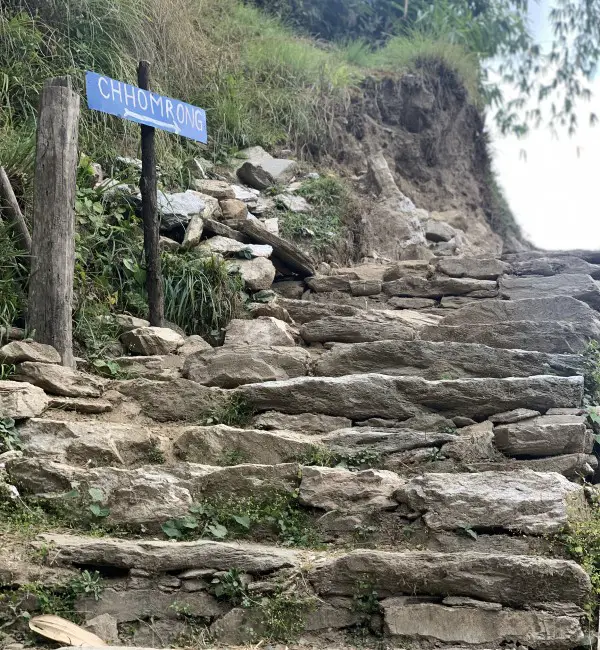
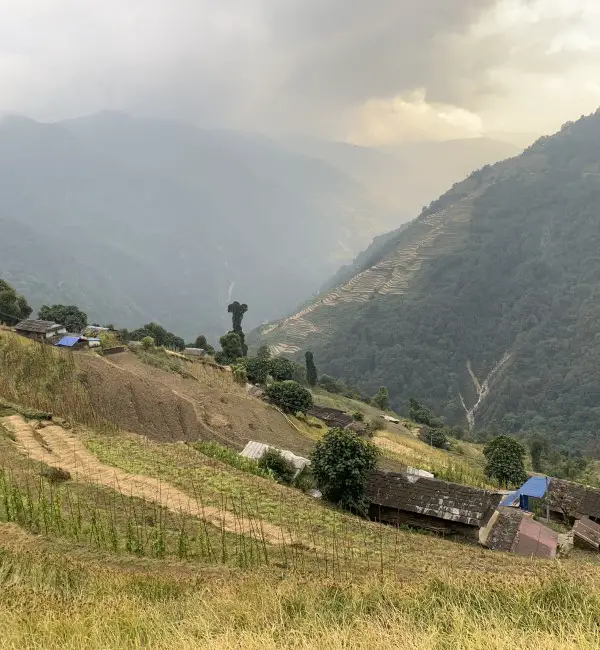
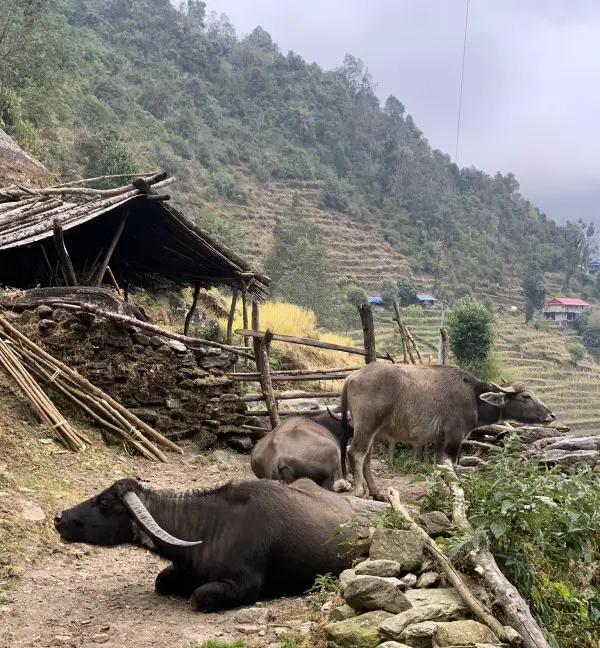
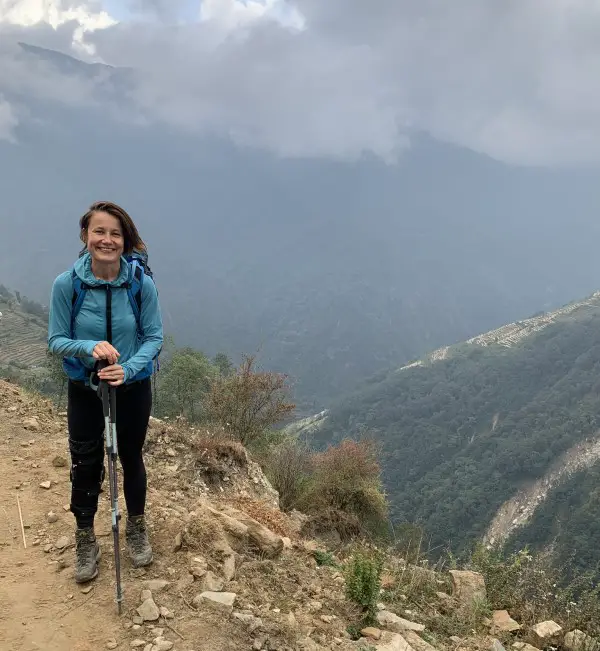
Arrived!
Choosing the best lodge in Chhomrong
The lodges situated in the upper part of the village offer the best views of Annapurna South, Hiunchiuli and Machapuchare.
When choosing a lodge, check whether the water in the shower is heated by the sun or gas. Solar panels, especially on cloudy days, do not always ensure a satisfactory water temperature. Additionally, when there are many people in the hotel, the hot water often runs out quickly… If you really need a hot shower, it is safer to opt for gas heating.
Views from Upper Chhomrong are amazing!!!
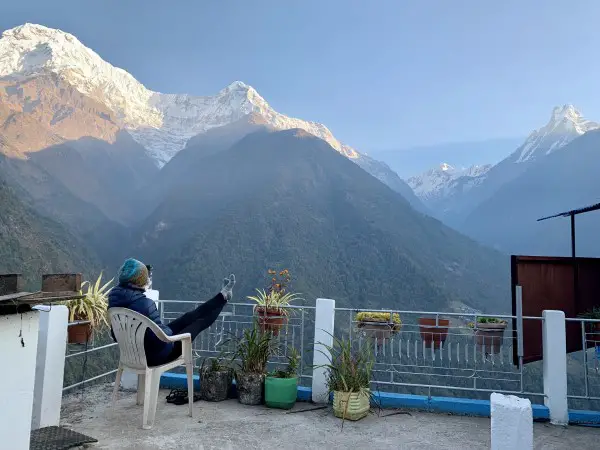
Accommodation in Chhomrong
We chose the Excellent View Top Lodge recommended by Lonely Planet, but we didn’t like it too much. The dining room and the shower were cold and the food so-so. But if you’re looking for company, Chhomrong’s most popular lodge is probably your best choice.
Price per night at Excellent View Top Lodge in Chhomrong: NPR 1200 per room with toilet and hot shower with hot water that, in my case, has run out. Well, solar heated showers can sometimes be tricky. Rooms without a shower cost 600 NPR.
Excellent View Top Lodge
in Chhomrong


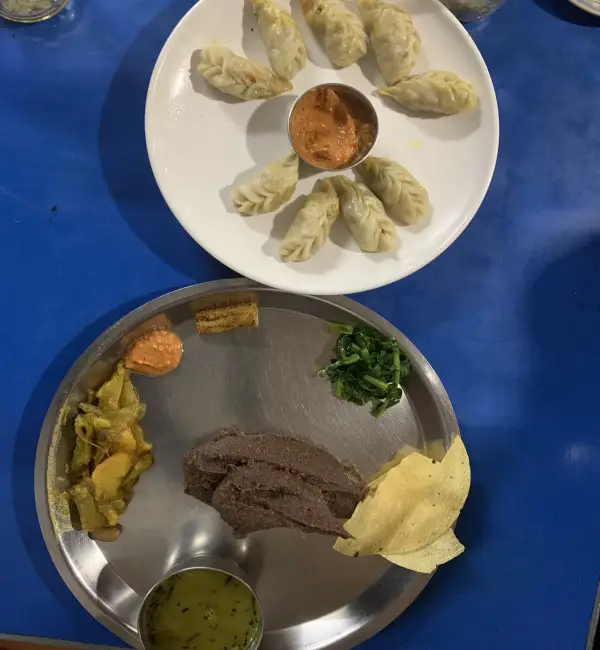
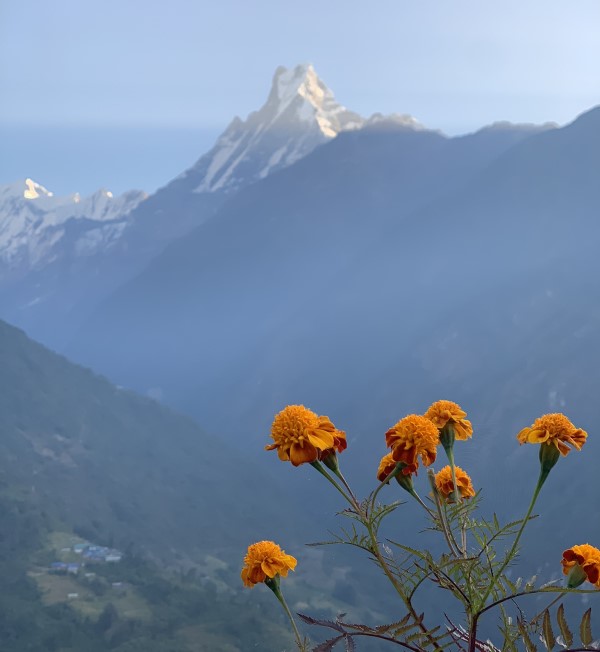
the view was excellent,
no doubt about it
DAY 3. Chhomrong 2140m > Sinuwa 2340m
500m ascent | 300m descent | 4 km | 3hrs
After drinking a double espresso (oh yes, they have great coffee in Chhomrong) on a spectacular terrace overlooking the Himalayas, we set off with verve. After 5 minutes, however, we had to stop to show our permits at the ACAP Tourist Checkpoint.
Like the day before, it wasn’t going to be easy either. Actually, I found hiking to Chhomrong and Sinuwa the most difficult parts of the entire trek. Later, it became easier and easier.
In Chhomrong, we descended over 2,000 steps to a swinging suspension bridge at 1860m. This was the easiest part of today’s hike. After crossing the bridge, we started the steep climb, passing the tiny hamlets of Tiliche and Bhanuwa (aka Lower Sinuwa), where we had lunch at Real Sinuwa Cottage.
Through the idyllic village of Chhomrong
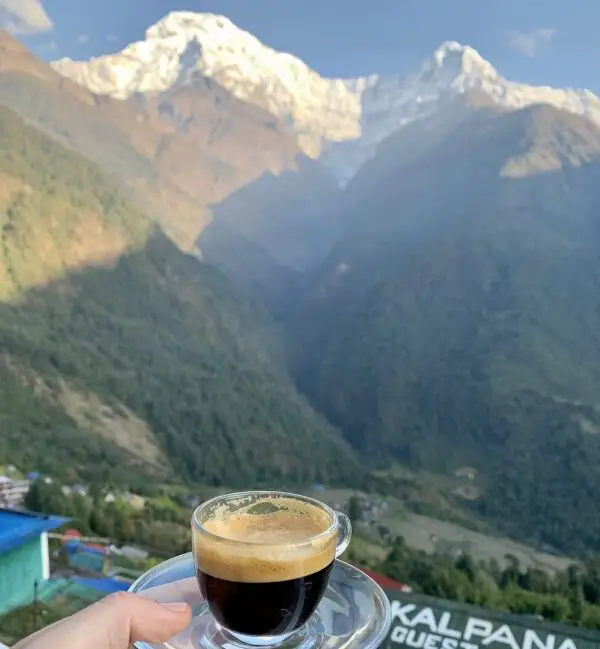
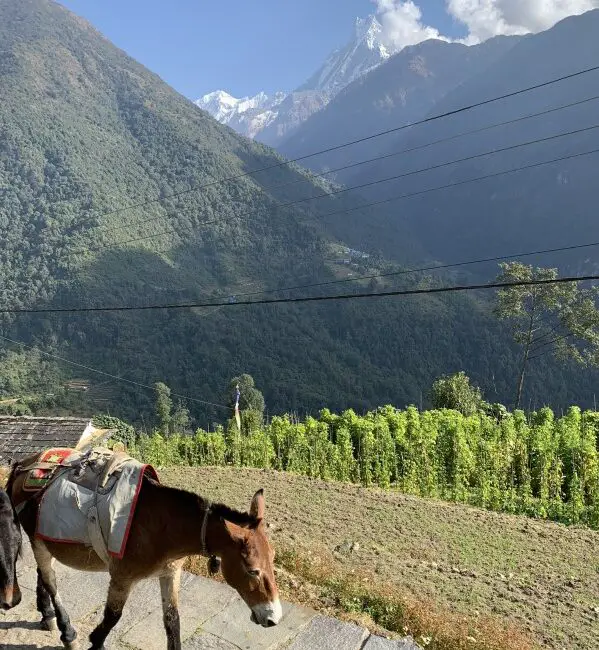

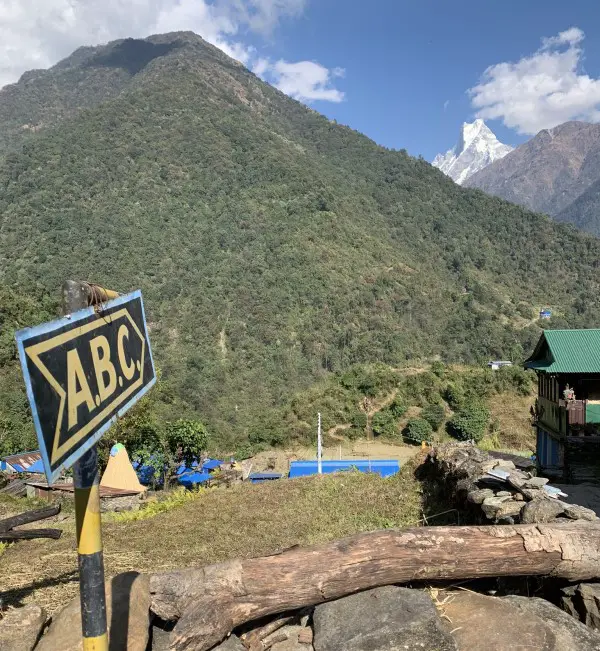
towards the adventure!
While sitting on the sunny terrace and enjoying a delicious omelette with chapati and crispy vegetarian pakoda, we watched a man brush his horse’s mane with so much love. What a beautiful scene!
lunch time is the best time!
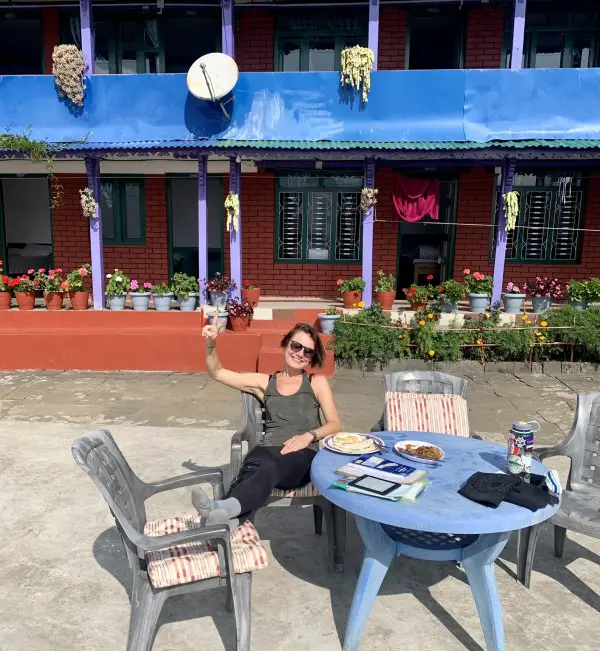


The last approach to Sinuwa turned out to be hard. It was hot and steep and our backpacks were very heavy. Initially, the plan was to reach Bamboo, but we stopped earlier in Sinuwa, because we were tired, and dark clouds started rolling over the valley and it got cold. Of course, we could continue like most people, but that wouldn’t be very pleasant. Since we wanted to enjoy every minute of our journey, we simply changed the plan and stayed at Sinuwa.
A moment of relax after climbing the steep stairs in the scorching sun...
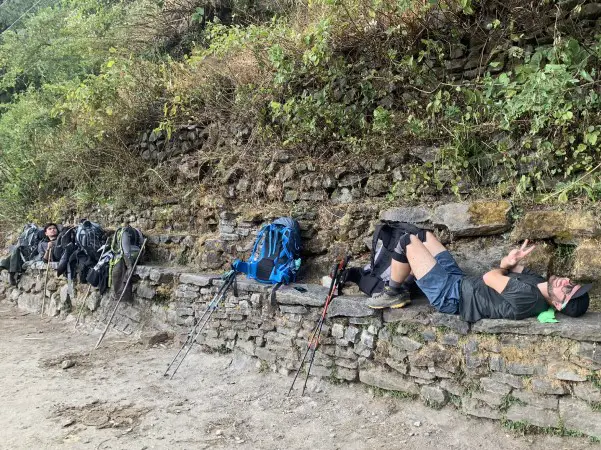
How about staying in Sinuwa?
Most people go from Chhomrong directly to Bamboo and the next day from Bamboo to Himalaya or Deurali. Especially if you plan to reach “only” Himalaya, it is worth considering an overnight stay in Sinuwa to spread the effort more evenly over two days. The Sinuwa-Himalaya section is easier than Chhomrong-Sinuwa anyway.
Accommodation in Sinuwa
There are only three lodges in Sinuwa. We chose the first – Hill-Top Lodge. The shower was hot, the momo and veggie thukpa (typical Nepalese noodle soup) tasty and the bed comfortable. Just perfect.
Price per night at Hill-Top Lodge in Sinuwa: NPR 300 for a double room with shared toilet + NPR 250 for a gas-heated shower.
in Sinuwa I found all I need to be happy: good view, comfortable bed & tasty food
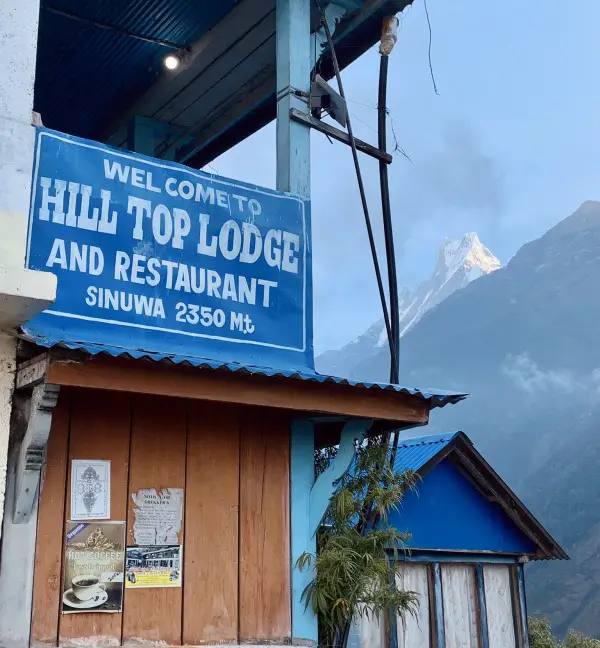
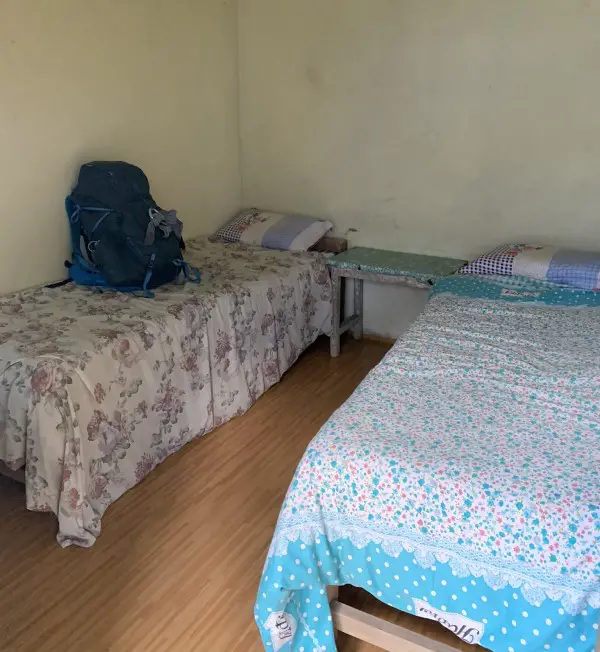
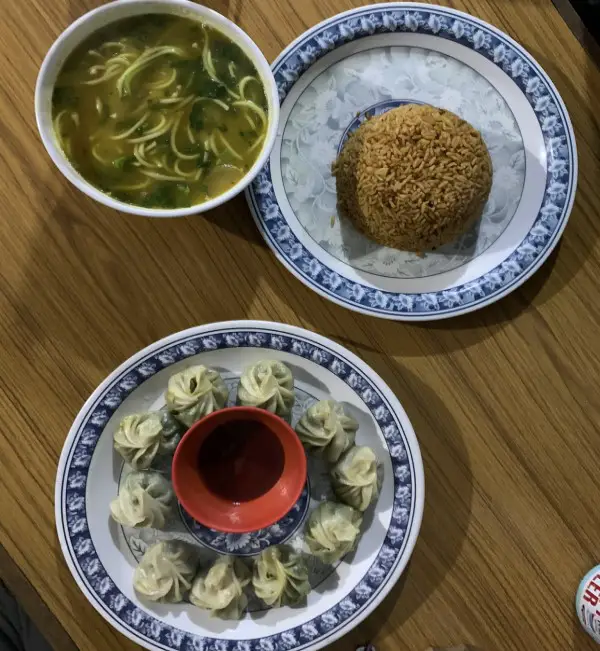
DAY 4. Sinuwa 2340m > Himalaya 2840m
680m ascent | 180m descent | 8.5km | 5hrs
Gurung bread (typical Tibetan bread) with peanut butter, which I bought in Pokhara and carried in my backpack since then, ginger tea and off I go! Such breakfast has become our daily ritual.
The whole day was pleasant and not too difficult as the ascent was gentle. The trail led gradually uphill, there was only one steep descent just before reaching Bamboo – stone steps from Kuldi (2470 m).
We were very happy that we walked this part in sunny weather. It was a smart move not to push ourselves the day before. The views of Machapuchare in between bamboo trees were breathtaking. In addition, there were plenty of attractions on the way: a little temple and beautiful waterfalls. We even met black-faced langur monkeys in the forest just outside Dovan.


Trekking from Sinuwa to Dovan
Below is our approximate walking time, but remember that we do not walk fast. The distances are short, the settlements are very close, so you don’t need to plan much in advance and just stop for a night or lunch when you’re ready.
- Sinuwa-Bamboo 2hrs,
- Bamboo lunch break 75 min,
- Bamboo-Dovan 75 min,
- Dovan-Himalaya 2hrs,
- Himalaya-Deurali 2hrs (on Day 5).
Accommodation in Himalaya
A good coffee machine at Himalaya Lodge immediately caught our eye. And indeed, the morning coffee was great. The shower was hot and the dining room was warm thanks to the heater under the table.
Hot shower, momos & gurung bread with peanut butter.
My smile says it all!
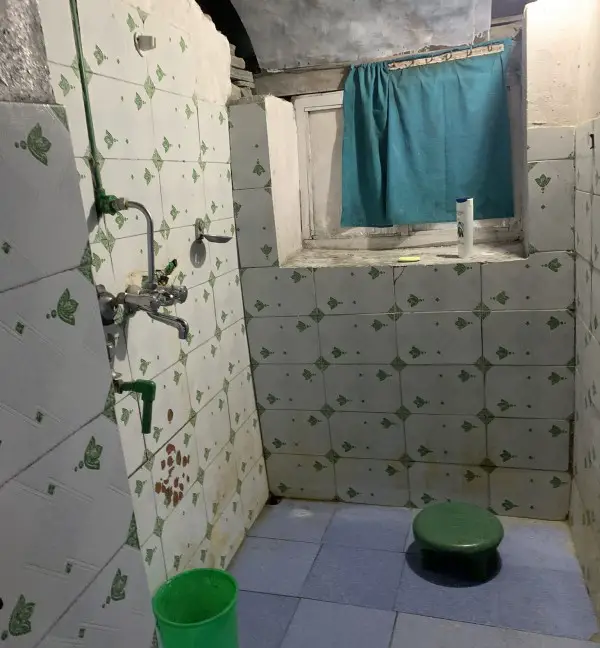
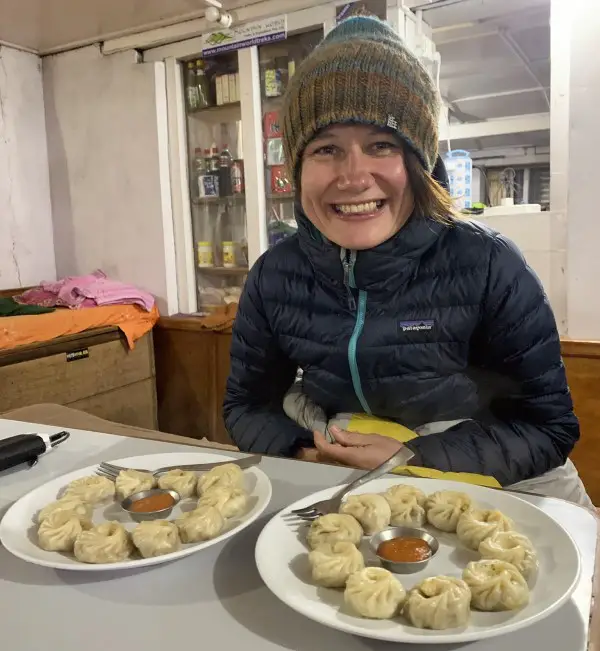
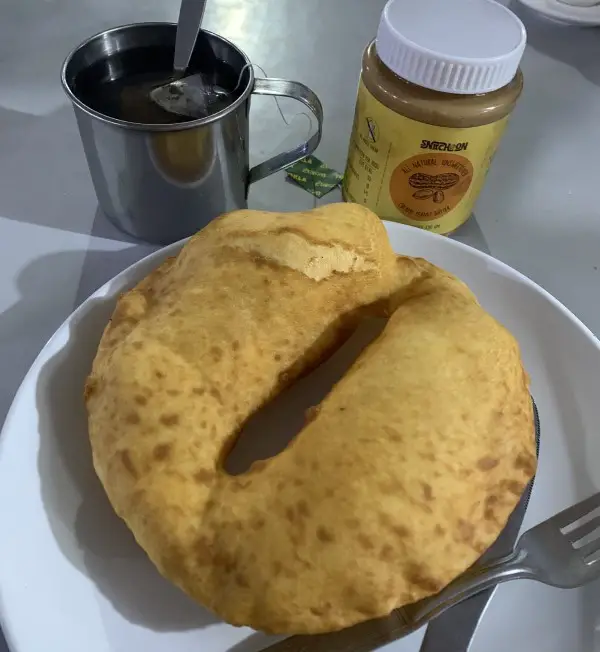
when the heater was on, the dining room was warm, but earlier,
as you can see, it was a bit chilly...
In fact, cold dining rooms are something new for me. On other treks (EBC, Annapurna Circuit, Mardi Himal) dining rooms were always heated with firewood or yak droppings burned in the stove. As Annapurna Sanctuary is part of the Annapurna Conservation Area Project (ACAP), firewood is prohibited by law and there are no yaks in the area. Sometimes (especially in winter) a kerosene heater is placed under the table and turned on, for which you often have to pay extra.
Price per night at Himalaya Guesthouse: NPR 600 for a double room with shared toilet. Hot (gas) shower included. Highly recommended!
Chilling before dinner-
that's how you roll
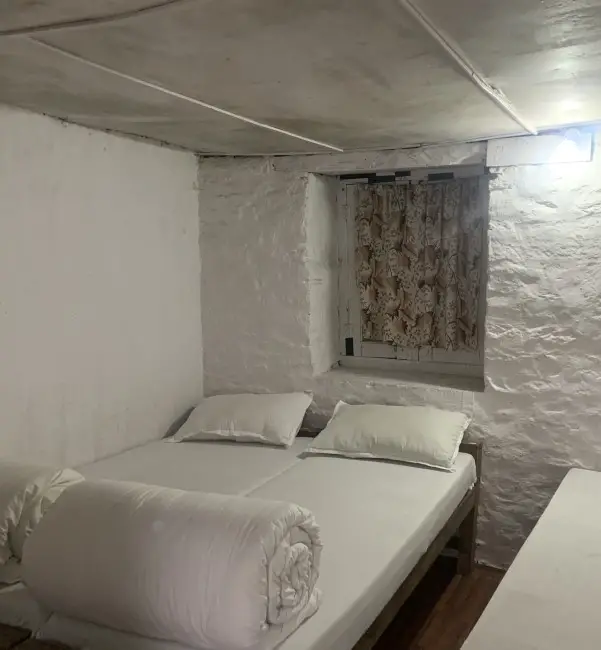

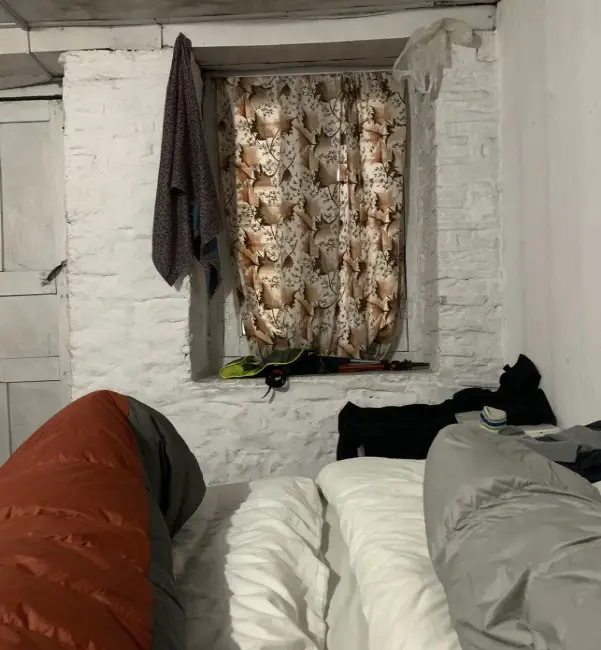

at himalaya!
DAY 5. Himalaya 2840m > MBC 3700m
860m ascent | 6km | 5hrs
The gurung bread at the Himalaya Hotel was particularly fresh and the double espresso gave us the kick we needed. After breakfast in the company of two trekkers from Slovenia we set off. I took it as a good omen, because you must be lucky to meet Slovenians in the remote Himalayas, since there are only 2 million of them in the world, right?

<-- On the way
to Deurali-->
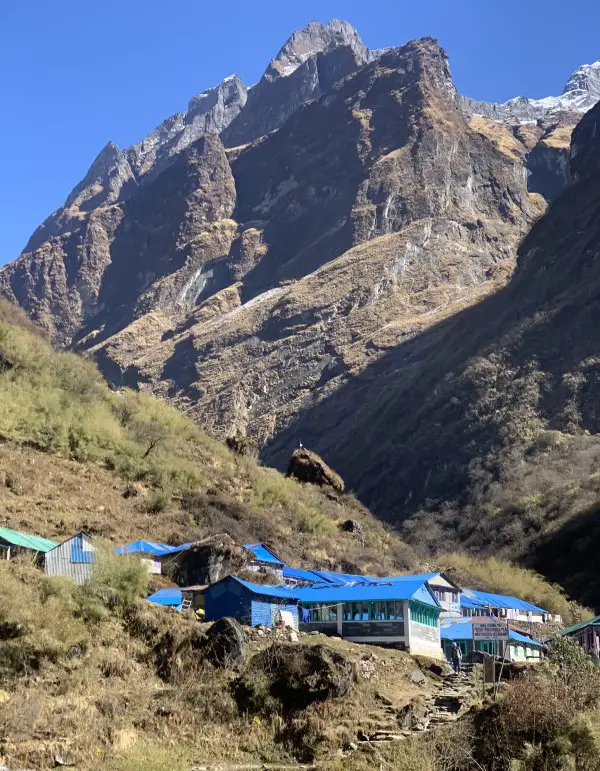
It was an easy 2 hour walk to Deurali where we had the same lunch as everyday – omelette, chapati and fried potatoes which we never got tired of.
Honestly speaking, I wasn’t sure if we should continue hiking due to the significant altitude gains and the risk of altitude sickness. We felt great though, and most people were climbing at an even faster pace than us, so we continued.
The route was amazing and easy. Just above Deurali, the valley becomes less steep and you can see the “gates” to the sanctuary in the distance. The views are magnificent and you can really start to feel the presence of the mountains.
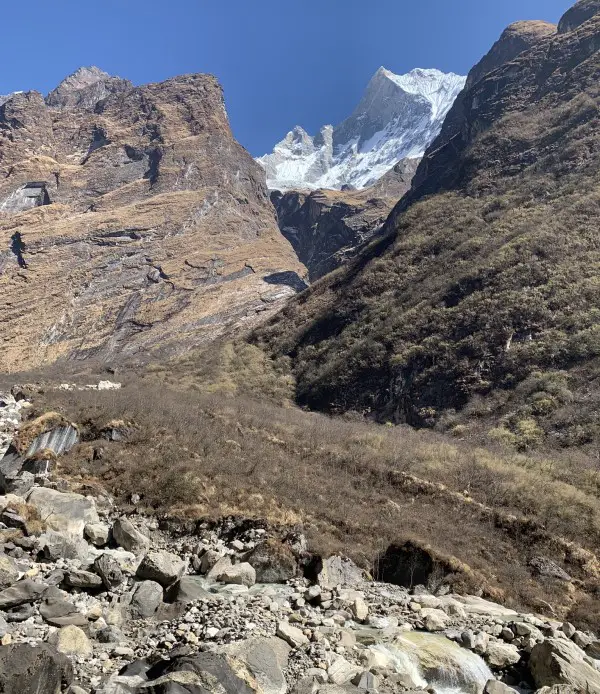

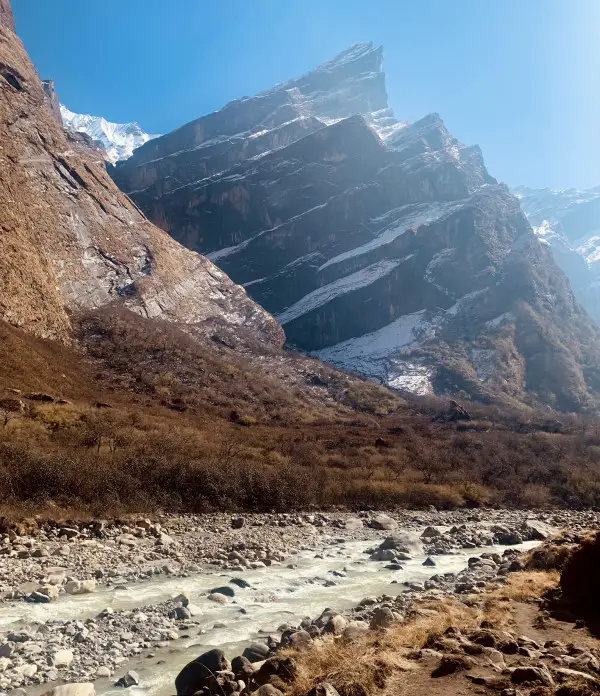
Dangers when trekking to Machapuchare Base Camp (MBC)
After heavy snowfall, the section between Deurali and MBC can be particularly dangerous due to avalanches from Hiunchiuli and Annapurna South that crash into the valley at great speed. If it has snowed recently, ask hotel owners in Deurali if it is safe to cross the valley.
November is one of the safest months for trekking

Machapuchare Base Camp accommodation
We chose the Gurung Co-Operative Guesthouse, much quieter than the bustling Fishtail Guesthouse, and there was nothing to complain about. It was a good place to rest.
Price per night at Gurung Co-Operative Guesthouse: NPR 500 for a double room with shared toilet. The water in the pipes was frozen so there was no shower.
a splendid view of Machapuchare & how the weather can change in less than 10 minutes
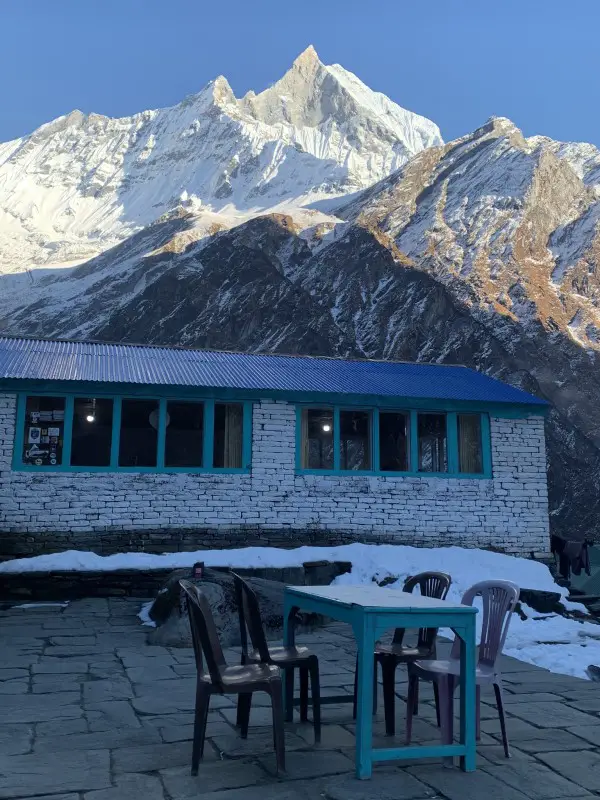
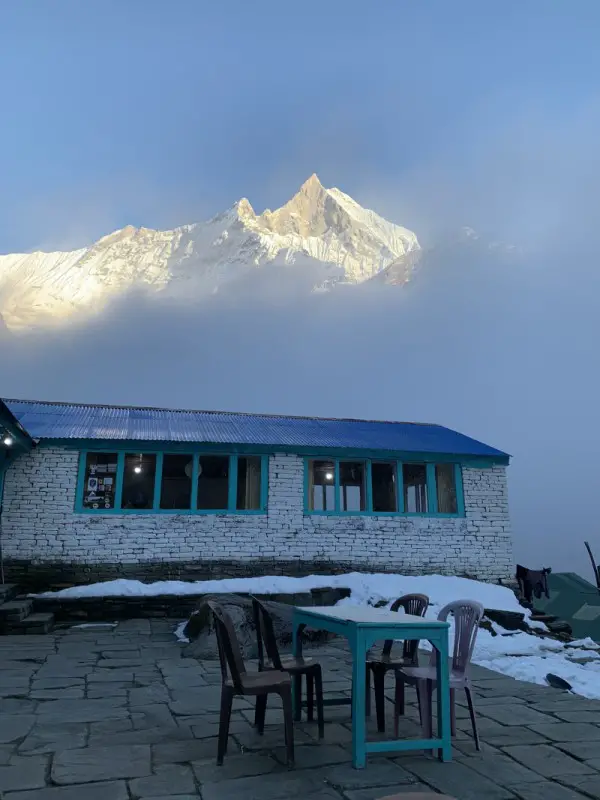

DAY 6. MBC 3700m > ABC 4130m
430m ascent | 3km | 2.5hrs
I couldn’t sleep well in MBC, probably high altitude was the culprit. Crawling out of the warm sleeping bag was more difficult than usual. We didn’t set off until 9 as we wanted to hike when it’s warm – when the sun is already rising over the valley.
I have to agree with the Lonely Planet guide, that trekking to the base from MBC “is a pleasant walk”. You gain altitude gradually and hardly feel you are climbing as the ascent is so gentle. Don’t be fooled by the view of the ABC lodges in the distance as it takes a while to get there. We walked for over two and a half hours, but we must have stopped hundreds of times to take thousands of photos. The views of Machapuchare behind us and the Annapurna Sanctuary getting closer with each step were simply irresistible.
We arrived at the base camp at 11.30 and quickly ordered food which we ate in the sun chatting with a nice couple from a large British trekking group. After lunch, we walked to the viewpoint (300m/flat) to enjoy the magnificent views of Annapurna’s almost vertical south face towering over the sanctuary.
I felt great and had no altitude sickness symptoms at all. Andrea had a slight headache before the dinner but after ibuprofen (the best painkiller in the mountains) felt better straight away.
Tips for trekking from MBC to ABC
If you don’t have enough time to stay overnight at the base camp or want to reduce the risk of altitude sickness, leave your backpack at MBC and head to the ABC in the early morning with only the essentials. Some set off before sunrise to see the Annapurna Base Camp in the rays of the rising sun. Enjoy this beautiful spectacle of nature, have breakfast or at least a hot tea in one of the cosy lodges and return to MBC after. From where you can continue to Deurali or even Himalaya on the same day. This will allow you to shorten the trek by one day and avoid sleeping above 4000 m.
Mornings at Annapurna Base Camp are usually clear and guarantee the best views, while afternoons are cloudier. So, unless you’re staying overnight at ABC, try to arrive in the early morning. And if you do, get up for sunrise, it’s really worth it. The changing light and colours over the peaks of Annapurna and Machapuchare create a stunning show!
the magnificent view of Annapurna (8091m) from the base camp
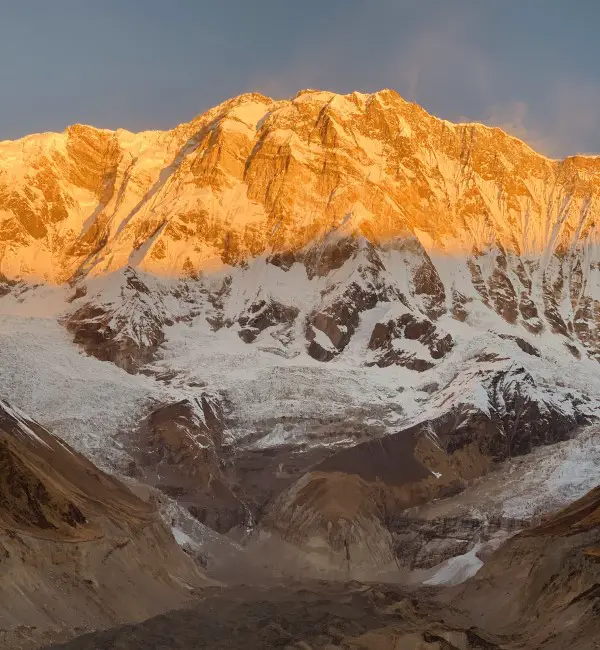

Accommodation at Annapurna Base Camp
Annapurna Guesthouse is the first lodge on the right after entering the base. It was also the first hotel during our trek that was full of people – a nice international crowd. The food was amazing and the dining room, even without the heaters on, didn’t feel too cold (probably because there were so many of us there). Highly recommended!
Life in at 4130m
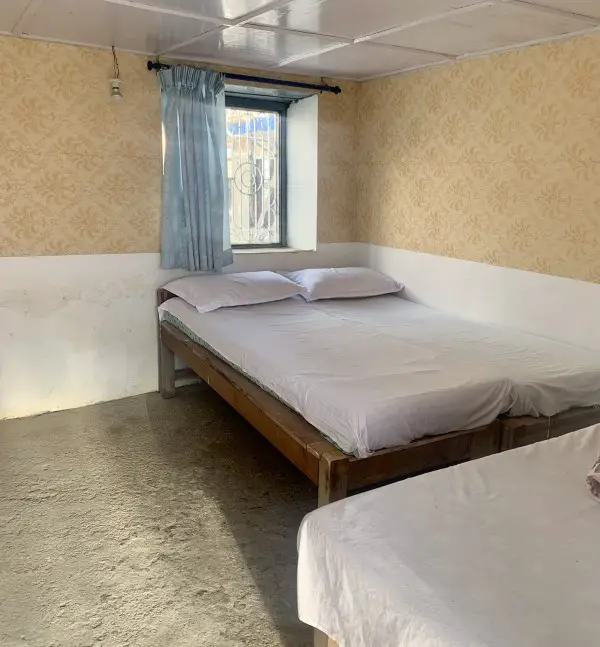

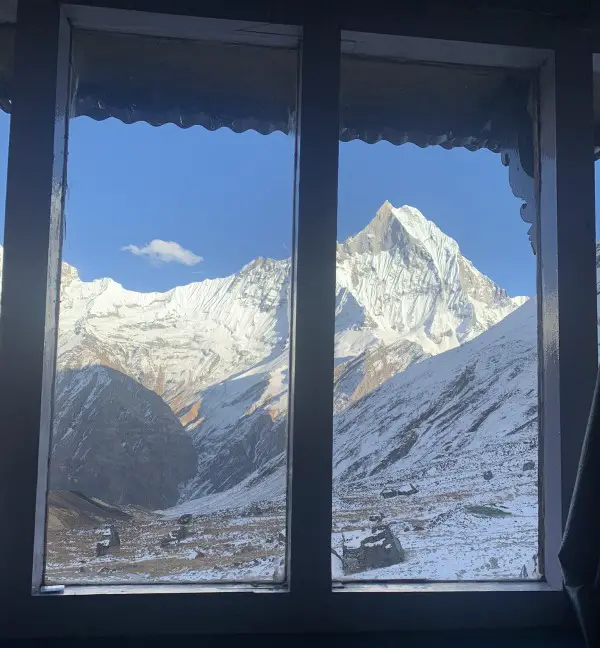
Price per night at Annapurna Guesthouse: NPR 500 for a double room with shared toilet. We didn’t even ask for a shower, instead we used wet wipes for the second night in a row, which is part of the adventure after all 🙂
DAY 7. ABC 4130m > Deurali 3230m
900m descent | 7km | 4hrs
I slept like a baby. When I got up at night to go to the toilet, the dark blue sky was full of stars! When I woke up at 6, I was happy that we decided to stay the night at the base camp. We didn’t have to climb anywhere. It was enough to step out of the room and the view was breathtaking. We headed towards the viewpoint to enjoy the amazing sunrise.
Most people left the base camp around 8 so we had the entire Annapurna Sanctuary to ourselves. No words can describe how amazing it was to be alone with the snowy giants.
Just after 10 we started descending to MBC where we stopped for lunch. When we reached Deurali after two hours of hiking, we were tired. If we were in a hurry, we would probably continue, but luckily, we were not so we decided to stay in Deurali.
Way back from the Annapurna Base Camp
Annapurna Base Camp trek is not a loop like the Annapurna Circuit. Therefore, I expected that going down the same route would not be too exciting, which of course turned out not to be true. Staying for night, or even for lunch in different places than on the ascent, made the way back from the base camp equally interesting.
We didn't mind stopping again at MBC on the way down.
Because how can you get tired of a place like this?

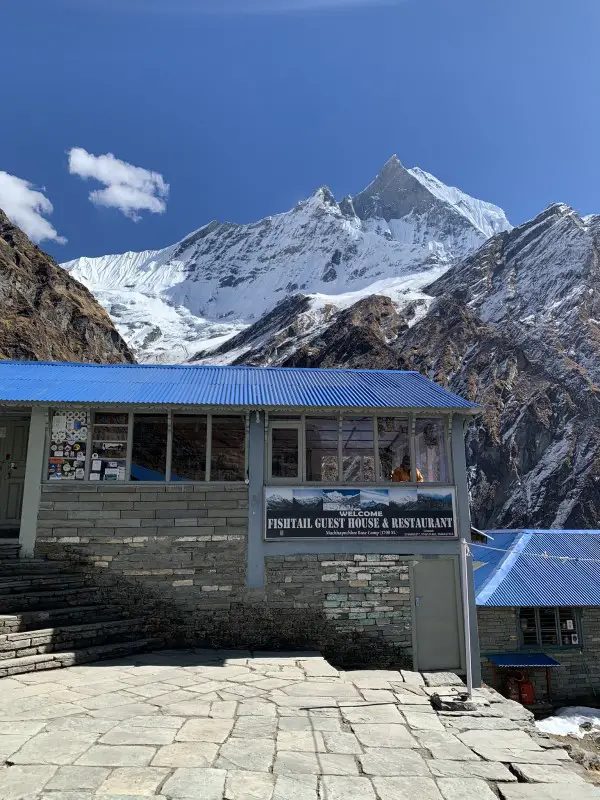
Accommodation in Deurali
Our second Shangri-La Guesthouse on the trek. The lodge was cosy, the young lady manager thoughtful, and the hot shower was actually hot. The food was a bit disappointing and for the first time we were charged for charging our phone.
Price for a night in Deurali: 500 NPR for a double room with shared toilet.
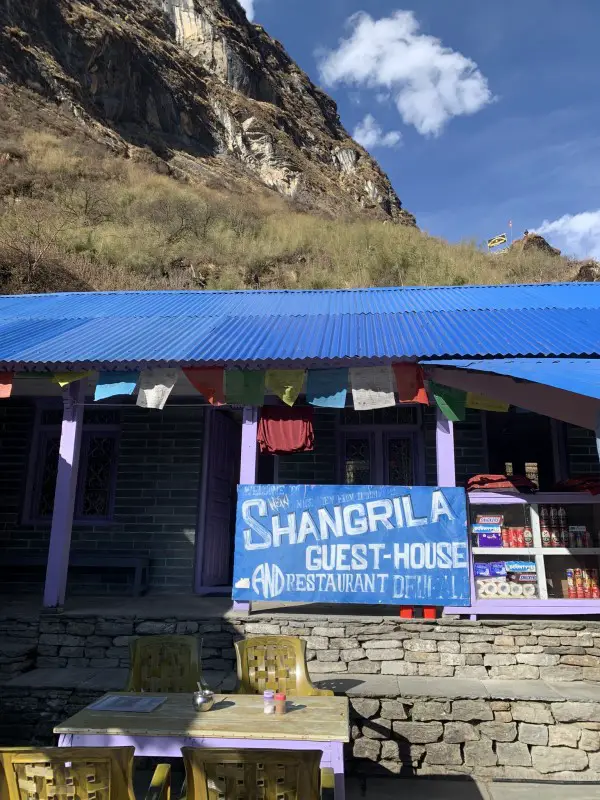

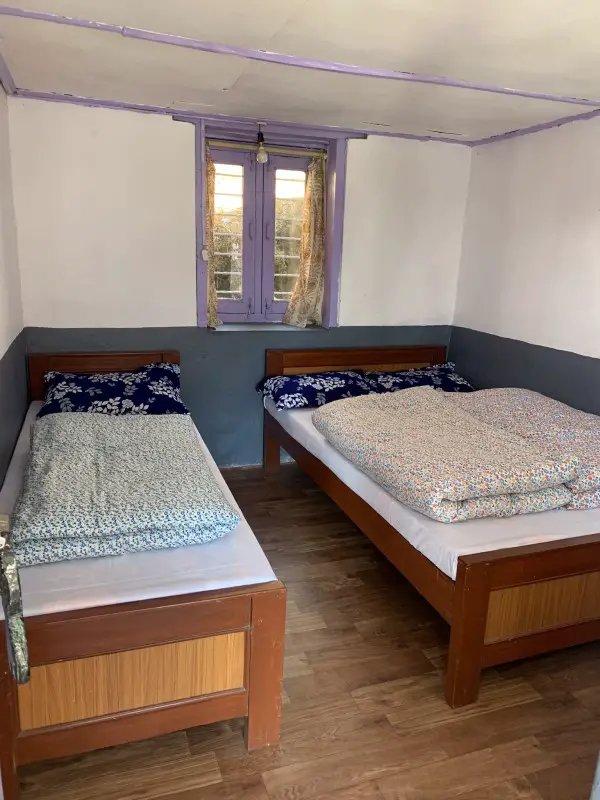
DAY 8. Deurali 3230m > Bamboo 2335m
1040m descent | 140m ascent | 7km | 4hrs
As usual, the weather was great. But today not only the blue sky and the sun were our hiking companions. Up to Himalaya we walked with a beautiful, very friendly black dog, who was just looking for some company and was going in the same direction. Stray dogs in Nepal are the most friendly and harmless creatures that are always looking for some love.
Our new trekking companion
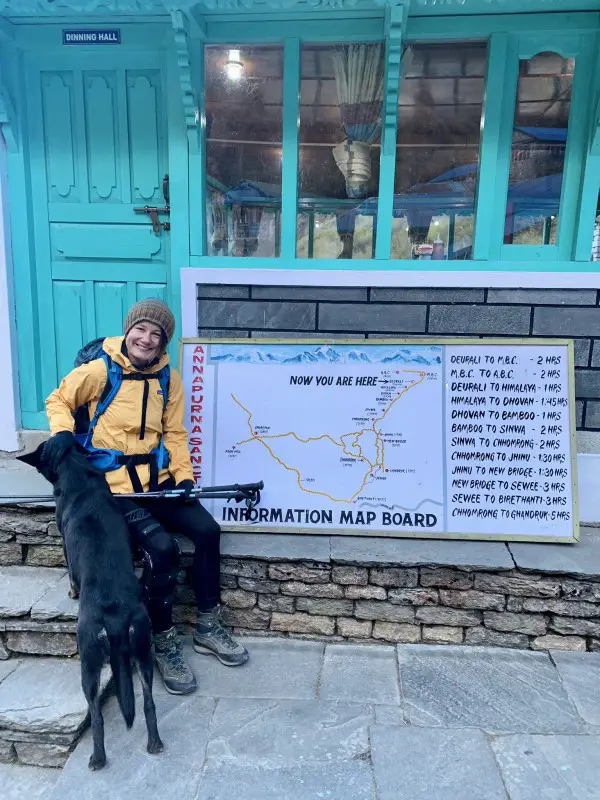
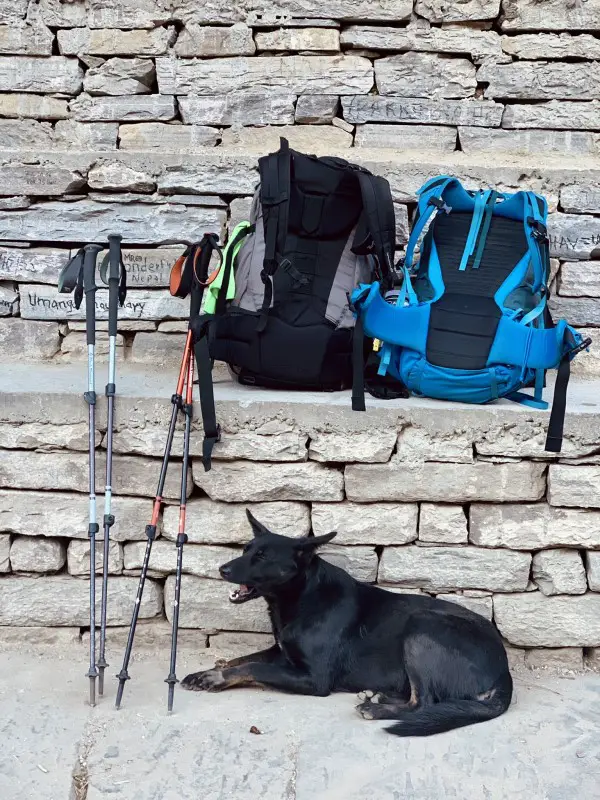

Descending to Bamboo
Most people (if not all) hike from base camp to Bamboo in one day. This of course means a much longer walking day, but it is perfectly doable. It’s a good idea if you want/need to get back to civilization faster. We didn’t 🙂
Our approximate walking time:
- ABC-Deurali 4hrs (on Day 7)
- Deurali-Himalaya 75 min,
- Himalaya-Dovan 1h30min,
- Dovan-Bamboo 1h.
Accommodation in Bamboo
Bamboo Guesthouse was a little bit dated but we chose it as we were tempted to relax at the little, sunny “square” in front of its building. It was a great spot to watch passing hikers over the tea.
Price per night at Bamboo: We were the first guests at Bamboo Guesthouse that day and the owner gave us a special discount. We only had to pay for the food. The room was free. The surcharge per person for the gas shower was NPR 200, which is a normal practice when trekking in Nepal. After seeing local porters carrying gas bottles in wooden baskets on their backs, you pay this small fee with pleasure.
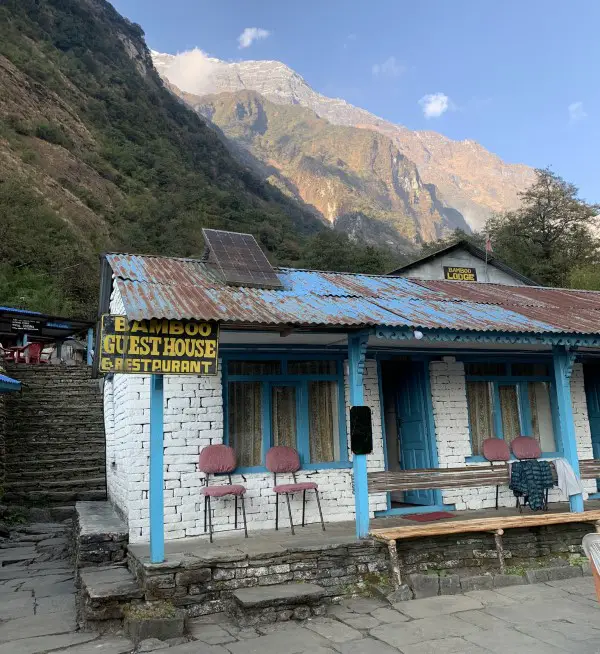
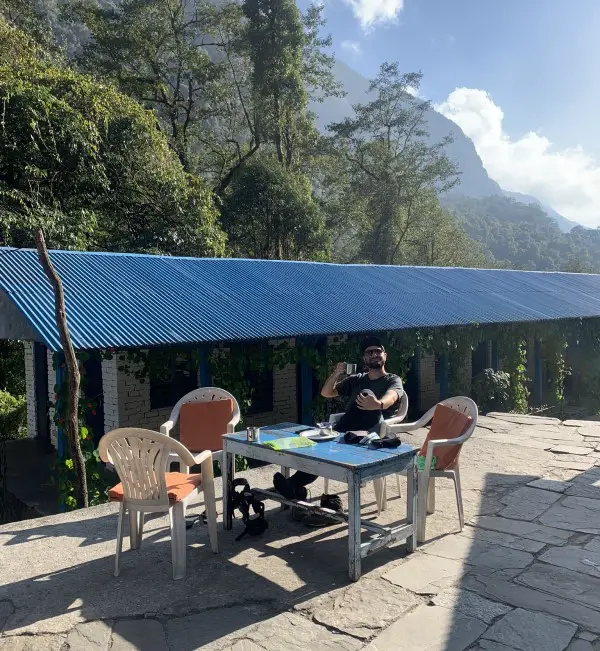
DAY 9: Bamboo 2335m > Chhomrong 2140m
510m descent | 610m ascent | 8km | 4.5hrs
Although the day started with a climb up the steep stone stairs from Bamboo to Kuldi, the hike to Sinuwa was very enjoyable. A flattish path leads through a beautiful forest. While walking, it’s worth looking back from time to time to make sure Machapuchare is still there 🙂

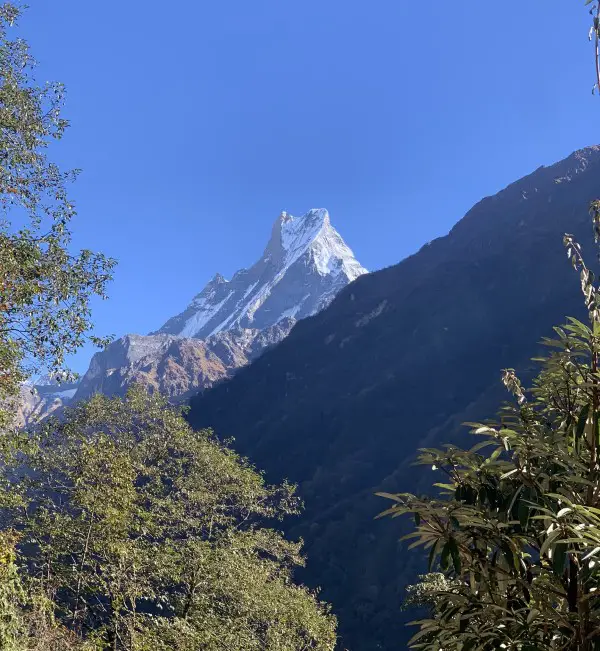
After lunch in Sinuwa, we retraced our steps down towards Chhomrong Khola. After crossing the bridge, the biggest challenge of the day was in front of us. Climbing the countless stairs to Chhomrong was endless. Actually, the stairs were rather “counted” as I counted them and I know exactly that there are over 2000 of them!
- Bamboo-Sinuwa 2 hrs,
- Sinuwa lunch break 1h30min,
- Sinuwa-down to the bridge 1 h,
- from the bridge up- to Chhomrong 1h30min.
It's so green again!
How to relax at the end of a long hiking day?
Trekking to the next village – Jhinu Dhanda takes only about an hour. If you are early and don’t want to spend the night in Chhomrong again but prefer to relax in the hot springs in Jhinu, just keep going.
Accommodation in Chhomrong
The International Guesthouse is located opposite the Excellent View Top Lodge, where we stayed before. Although it is one of the most popular hotels in Chhomrong, we were the only guests, which was pretty cool. You could feel the end of the trekking season approaching. The room was cosy and very clean, shower hot, dining room quite warm, food tasty and real coffee good. Much nicer than the Excellent View Top Lodge. 10/10 – highly recommended!
Double room price with shared toilet and shower at International Guesthouse in Chomrong: NPR 600. At this altitude, thanks to mules bringing gas cylinders, the cost of a hot shower is included in the room rate. No more excuses not to take a shower 🙂
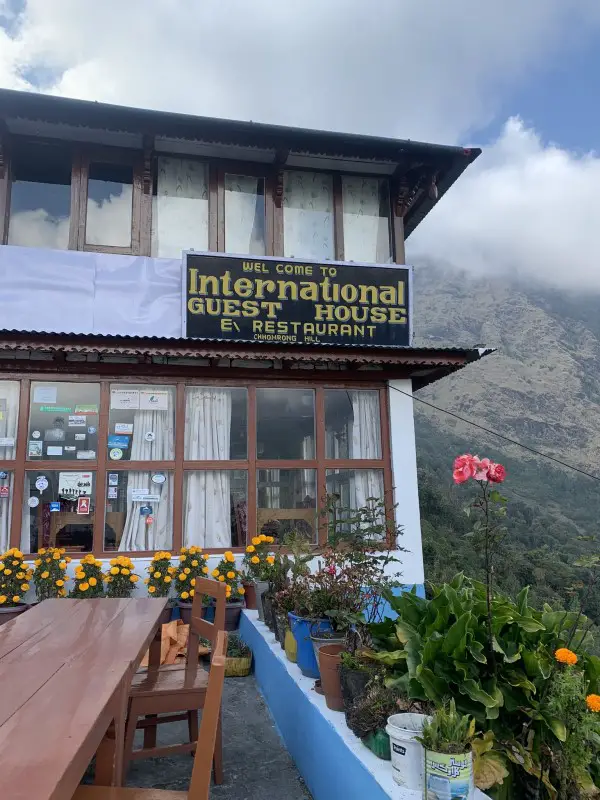

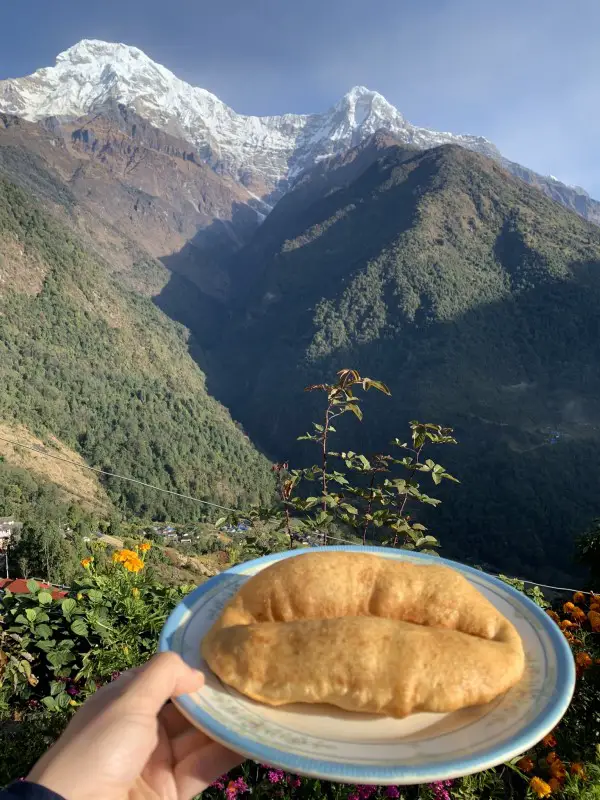
DAY 10. Chhomrong 2140m > Landruk 1565m
1115m descent | 300m ascent | 8km | 6 hrs
It was a really exciting day full of not fully planned attractions… It started as usual – we just hit the road. It took us an hour to reach Jhinu Danda (1750m). We went straight to the hot springs, cement baths by the rapid river, which are a great place to relax, especially after a multi-day trek (entry fee: 100 NPR). To get to the hot springs, you need to get off the main trail and walk downhill for about 15 minutes (to go up, it takes a bit more time).
After the bath and lunch in Jhinu, we headed towards the next attraction. The nearly 300-metre Jhinu Danda Bridge, completed in 2018, to facilitate access to the Annapurna Base Camp, is one of the highest suspension bridges in Nepal. Crossing the bridge was very exciting!
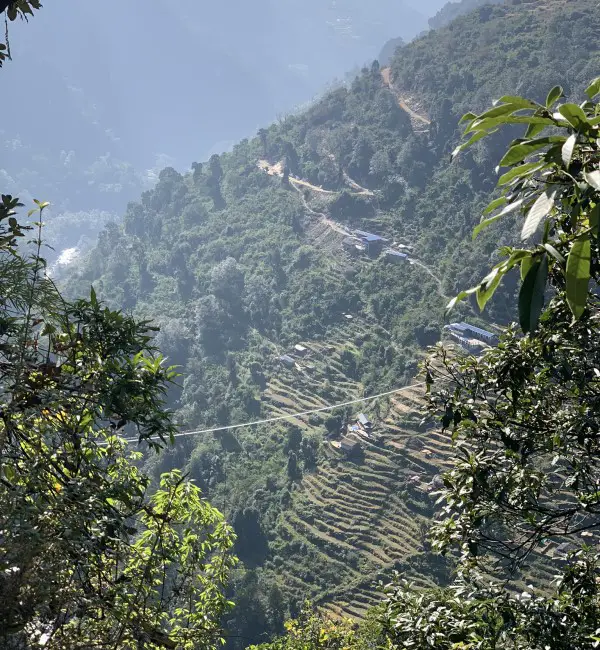

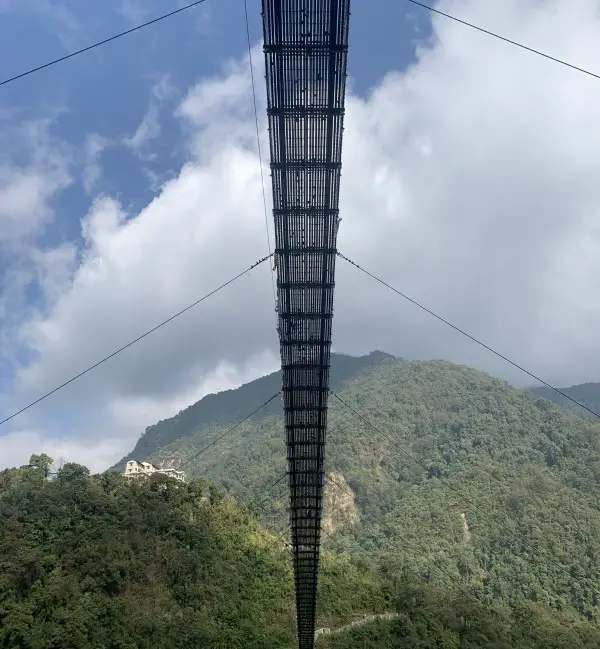
We walked an hour from Jhinu Danda to New Bridge (1410m). Unfortunately, after New Bridge we took a wrong turn and instead of crossing the river towards Himalpani Guest House, we continued our journey on the wrong side of the river. I don’t know why Maps.me suggested this path, badly damaged by landslides, that probably no one takes anymore. By the time we realised something had gone wrong, it was more convenient to continue to Landruk via Kyumi than to turn back.
A much longer route, constant ascents and descents, landslide damage, a frightened loud cow blocking our way, not very friendly-looking buffaloes a bit too close to us and steep stone stairs at the very end of a long day – it wasn’t something we enjoyed particularly. But we survived 🙂
Jhinu hot springs and how to quickly return to Pokhara
If you are planning to visit hot springs, leave your backpack at one of the guesthouses in Jhinu. You’ll pick it up on your way back, as you’ll probably want to stop at Jhinu for lunch or tea anyway. We didn’t think about it and regretted terribly on the way back from the springs. Walking with a heavy backpack took us longer. Plus, it was hot, and after a refreshing bath, the last thing you want to do is sweat again.
hot springs-that's exactly what you need after trekking

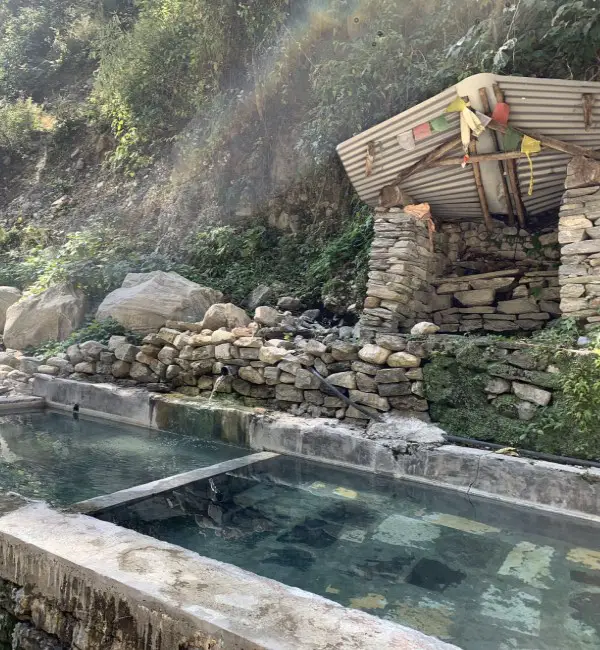
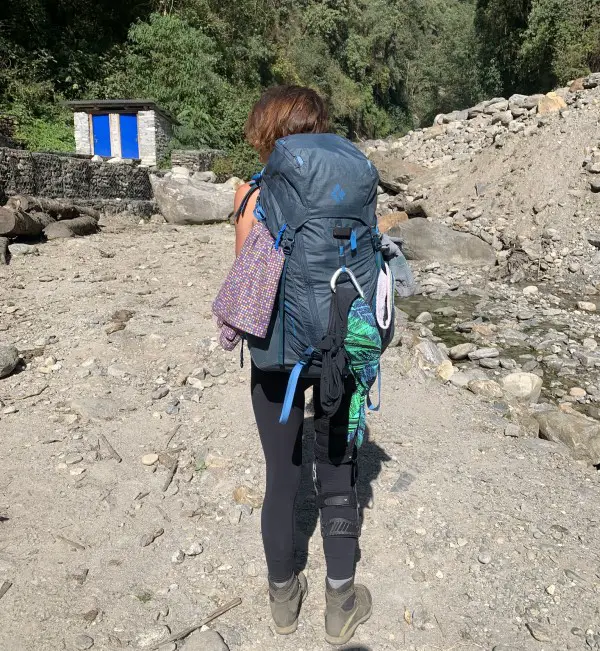
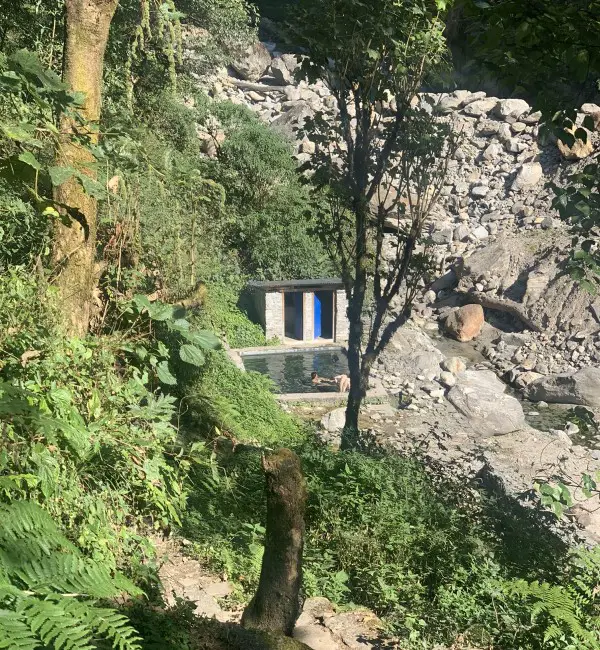
Just don't repeat my mistake, leave your backpack in Jhinu before heading down to the hot springs
To get to Pokhara quickly and save a day, skip Landruk and go to the jeep station at Simring after crossing the Jhinu Danda Bridge. It’s the fastest way to get to civilization. If you’re coming from Chhomrong or even Jhinu, you should get to Simring early and catch a jeep easily. I haven’t done it myself, so I won’t go into detail, but I’ve seen a lot of people go directly to Simring. Actually, we were the only ones going to Landruk.
Where to stay in Landruk?
We were so exhausted that we stopped at the first place we saw – Hotel Himalayan Front. The room was cosy, dal bhat tasty and overall decor and garden very nice. The shower was hot but surprisingly very poorly maintained. Had it been my first night on the trek, such an uninviting shower would have been a problem probably, but after 10 days of trekking, hot water was the only thing that mattered.
Price for a double room with toilet and shared hot shower: NPR 300. How cheap!
views from the Hotel Himalayan Front in Landruk


DAY 11. Jeep ride from Landruk (1565m) to Pokhara (820m)
On the last day of the hike, the jar with our beloved peanut butter also ran out. Well, there was really nothing left for us here but to go to the jeep station 😉 We had no idea what to expect, but as usual in Nepal, getting the things arranged for you was very simple. Two jeeps were waiting at the station and we were immediately asked if we wanted to go to Pokhara. A few local people were willing to share the ride and the travel costs.
Since Landruk is a very charming village, I wanted to explore it a bit before leaving. I asked if the jeep could leave a little later and… of course it was no problem. After a short walk around Landruk, we had lunch in the sun – a final omelette with chapati and potatoes served with the view of the Annapurna.
Annapurna views from the village of Landruk are like from some dream

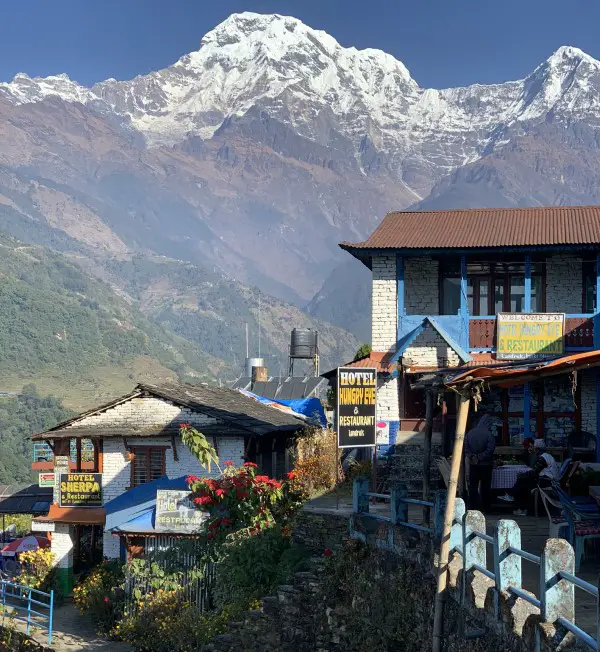
As agreed, at 10.30 sharp our 3-hour journey to Pokhara began. The ride in the jeep full of locals was fun. At the beginning, the jeep stopped every now and then so that another person could join or some interesting package could be delivered to the driver, who also acted as a village courier. Of course, in the end, there were more passengers than seats. The drive was less “scary” than the trip to Ghandruk though, there were hardly any other vehicles but us on the narrow mountain road.
Getting back to Pokhara from the Annapurna Base Camp trek by jeep
Also, in Landruk, if you don’t want to rent a private jeep, come to the jeep station in the morning as there is a better chance of meeting other people who want to share the ride.
Jeep station in Landruk

Put the rain cover on your backpack before placing it on top of the jeep, as it can get very dusty on the way. On the way from Ghandruk, the driver covered all the luggage with a special plastic cover, while the driver from Landruk did not. So, I guess there are no rules. As usual in Nepal 🙂
What’s next?
The jeep driver drove us all the way to Halan Chowk in Lakeside, from where we walked to my second home, where I spent over 6 months during the pandemic – Lakevision Guesthouse. Although our trekking adventure has come to an end, it was not the end of fun in Nepal! We had three full days to relax in beautiful Pokhara <3
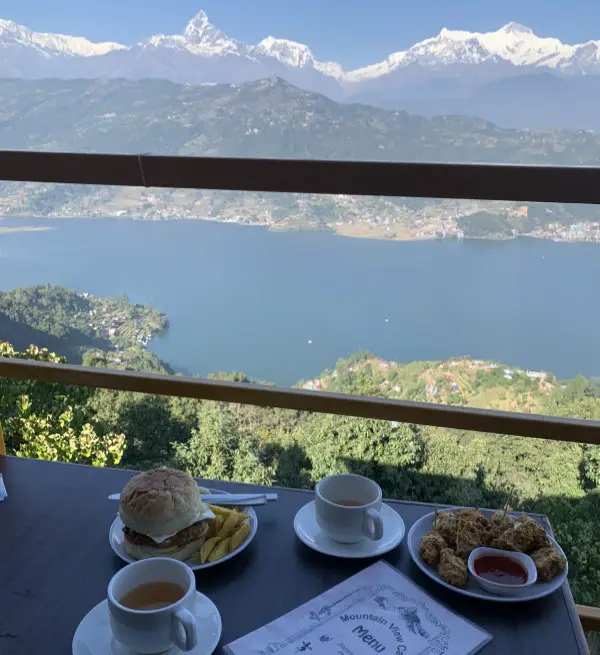
In Pokhara trekking might be over, but great views and good food haven't.
I hope you liked my trekking report of the Annapurna Base Camp, and more importantly, found it useful. If you still have some questions about Annapurna Sanctuary trek, please let me know in the comments. Have an amazing trip!
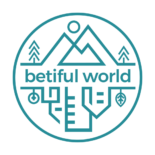
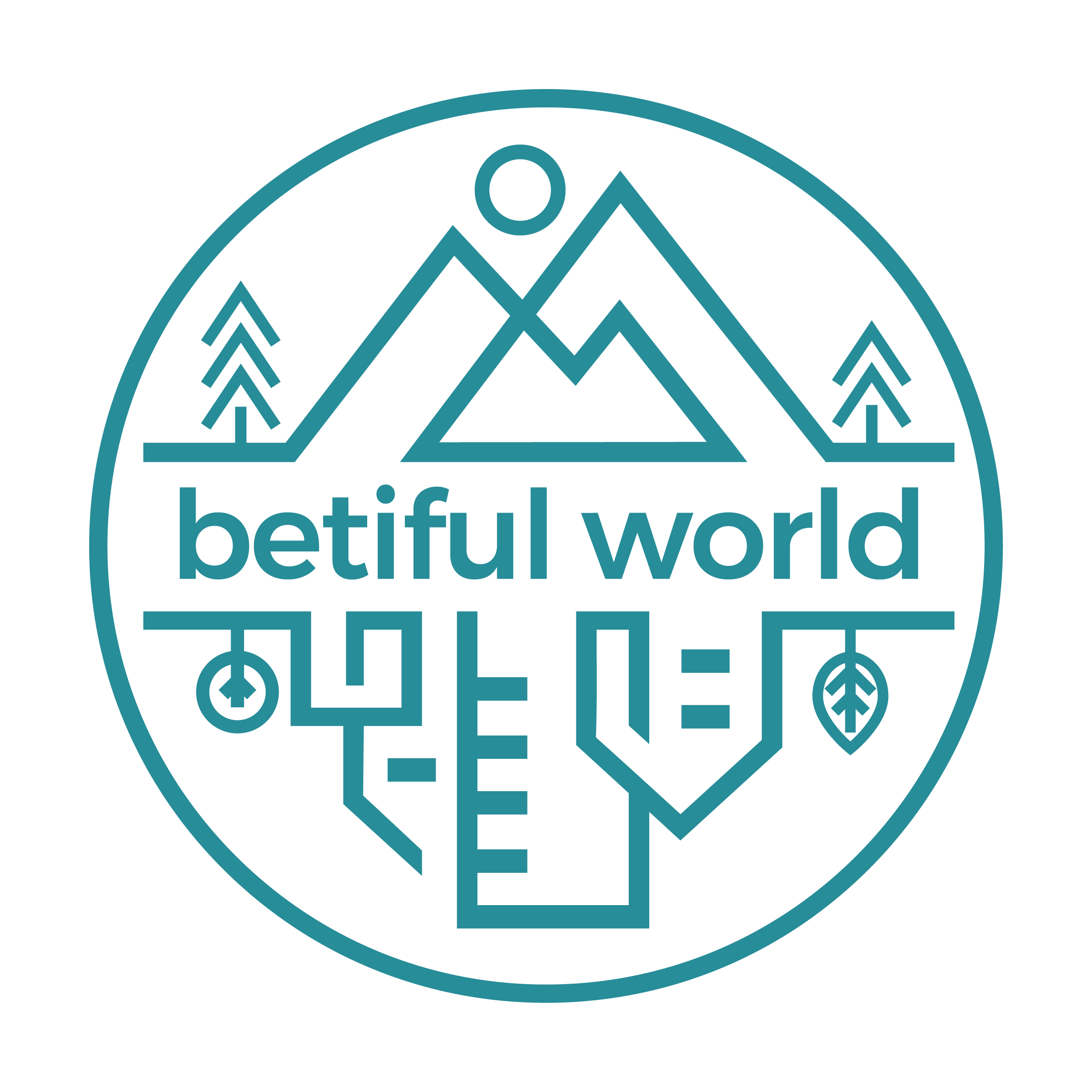
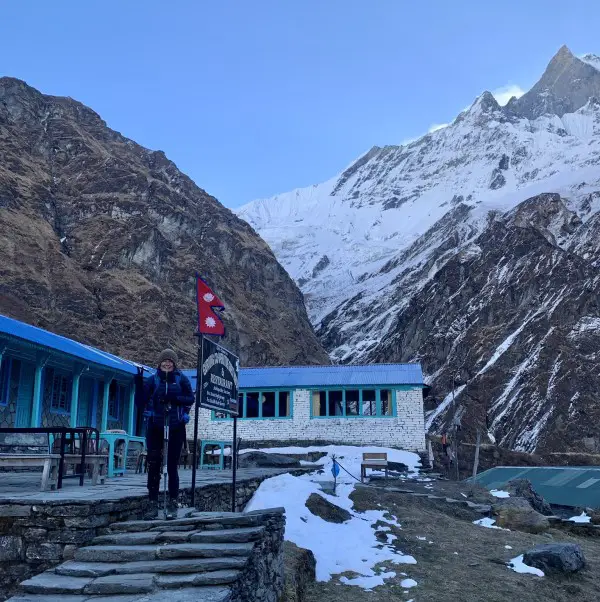












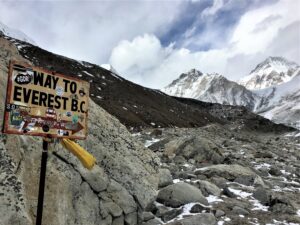
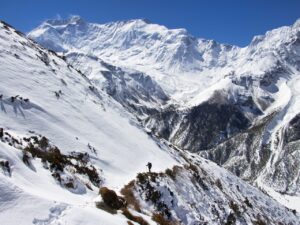
Hi
Congs to you! This is really very useful. I hope l will do and enjoy ABC trek in October.
Hi Erdal, thank you and I hope too as October is a great month to go trekking in Annapurna region!
Thank you for visiting Nepal and did Annapurna Base Camp Trek. Your post is really Amazing who willing to do ABC trek in Nepal.
Thank you Sir 🙂
Hi
Great blog! Do you know if the “without guide trekking ban”, will be implemented or not? Would like to do the ABC trek in October without a guide.
Hi Christian, nobody knows the answer for this question. But looking at the things how they go in Nepal now (and in general), I don’t think so (and I hope not). But that’s only my guessing. It’s been 3 months since the new rule, and all it caused is confusion as people still guide without a guide.
Yeah, I would like to know as well… Although we plan to go next year.
Such an informative article. Thanks for motivating more people to explore Annapurna Base Camp
I have read many blogs and studied itinerary on various websites, believe me after reading your blog all doubts are gone. Most informative blog covering each aspect is truly useful for every traveller. I am opting for relax itinerary given by you with little changes as suggested by you. Just need your view, if mid April or first week of May will be ok to plan. Thanks for sharing useful information.
Hello Alok! Thank you for your lovely message and for reading my blog. Sorry for not getting back to you sooner but I was travelling. Taking it slowly when trekking in the beautiful Himalayas is the best approach and I’m very glad that you think the same 🙂 If you have a choice, opt for mid-April as monsoon season starts in May in Nepal, and more rain and cloudier skies are expected. Good luck with planning and enjoy your adventure!
when i read this article it inspired me to go on a adventure like such. thank you so much
Thank you and please… plan your Annapurna adventure soon! 🙂
Hi, great great great article!!thank you!
Do you know if there is any update on the “mandatory” guide?
Hi Maria,
Thank you for visiting my blog. To answer your question – there is no update. You can still trek in Annapurna region without a guide and without issues. So don’t think too much about this ban, as it’s only on the paper, and plan your trek asap! You will love it!
Hope it helps,
Beti